




2023/2024





Year
in Review
We are Treaty people
SaskCulture’s work and support
lands covered by Treaties 2, 4, 5, 6, 8, and 10, the traditional lands of the Cree, Dakota, Dene, Lakota, Nakota and Saulteaux peoples, as well as homeland of the Métis.
Table of Contents
Land acknowledgement:
Message from
Chair Message from the CEO Staff and Board 2023/24 Members say.........2023 Membership Survey SaskCulture Mission, Vision, Ends and Strategic Priorities 03 04 05 06 07 Strategic Priority 1: Funding is Sustainable and Adaptable to Changing Needs 08 Board and Committees Culture Section of the Sask Lotteries Trust Fund for Sport, Culture and Recreation SaskCulture Financials 28 29 26 Strategic Priority 2: Improve Inclusiveness, Diversity, Equity, and Accessibility of Cultural Activity 18
reaches
the
2
Front cover photo credits: (From top to bottom) Jae Kim Photography, Métis Nation Saskatchewan, Kevin Hogarth, Culture Days Yorkton, FSI Studio (2023).

the Chair Message from
Reflecting on the year that has passed, it is heartening to see that more and more people are returning to the cultural activities they enjoy. Festivals are reporting stronger attendance, students are returning to weekly lessons, people are visiting galleries, museums and heritage sites, and communities are filling up their schedules with varied cultural events and activities. With this increased activity we see that applications for funding are on the rise. While some cultural experiences are still working to return to pre-pandemic levels, the cultural community as a whole has rallied and re-engaged many Saskatchewan audiences and participants, both in-person and online, who appreciate and value cultural activity in their lives.
Just as pleasing, in May 2023, SaskCulture, alongside our partners Sask Sport, Saskatchewan Parks and Recreation Association and Government of Saskatchewan, renewed the Lottery Licence Agreement for six years (2024-2029) with a 3.75 per cent lottery licence fee. As long as lottery ticket sales remain strong, this lottery agreement guarantees eligible sport, culture and recreation organizations will continue to benefit from Sask Lotterie's proceeds. Thanks to this funding, residents benefit from a wide range of cultural programming and services, which foster the growth of inclusive and engaged communities and contribute to individual well-being, community pride and overall quality of life throughout the province.
It’s important to note that by signing this agreement, SaskCulture agrees to help distribute funding to support these six public interest priorities: engaging diverse populations and creating inclusive communities; building community capacity and leadership engagement; supporting quality programs, facilities and environments; increasing accessibility; recognizing excellence and
celebrating achievements; and supporting individual well-being and active, healthy lifestyles.
Along with community needs, SaskCulture takes these priorities into consideration in its planning and review of funding options. It is hoped that the Funding Program Renewal Project currently underway will help us support an inclusive, diverse, equitable and accessible cultural community into the future.
As this is my last year as Chair, I want to take this opportunity to say a special thanks to my fellow Board members and to Dean Kush and the amazing SaskCulture staff for all their hard work and support throughout this busy but exciting year. In addition, a very large thank-you to the many members and community cultural leaders who are working each day to support Saskatchewan’s dynamic and vibrant cultural experiences. Their work, along with the dedication of the SaskCulture Board of Directors and SaskCulture’s staff team, is contributing to engaging residents in meaningful cultural experiences and creating a culturally vibrant Saskatchewan.
Sincerely,

3

the CEO Message from
This past year has been a testament to the resilience of Saskatchewan’s cultural community. There is still a lot of uncertainty out there, but the increased applications to SaskCulture’s funding programs show a province eager to engage in cultural activities. Cultural groups and communities are hosting more and more arts, heritage and cultural programming, providing a sense of optimism in turbulent times.
Programs such as Culture Days Saskatchewan, which sponsored 31 hubs last year, saw over 45,000 people participating in person and even more online–a 14 per cent increase from the previous year. Applications to Creative Kids also increased 24 per cent since 2022. Fortunately, the applications we were able to approve also increased by approximately 6.7 per cent. Since its inception in 2010, Creative Kids has been able to fund nearly 14,000 applications in 266 communities across this province to the tune of almost $7 million dollars, thanks to the generosity of donors, sponsors and support from Sask Lotteries.
Applications to SaskCulture’s other funding programs also rose last year. The Multicultural Initiatives Fund saw a record number of applications, an increase of 34.2 per cent, (55 applications in 2023/24, compared to 41 applications in 2022/23). In addition, our work this year with Gabriel Dumont Institute and the Northern Sport, Culture and Recreation District also yielded promising results with a 31 per cent increase in applications and confirmed our shared delivery granting model can deliver to the people of Saskatchewan. We also held the Museum Grant Program adjudication in 2023, which saw a record 113 museums receive their funding allocations for the next two years.
In February 2024, SaskCulture held its three-year adjudication of Annual Global Funding. I want to thank the peer assessors who waded through hundreds and hundreds of pages of applications to determine funding levels. This fund, which supports 30 provincial cultural organizations, supports the core of cultural programming in the province. I want to commend the Eligible Cultural
Organizations on their efforts in these applications to demonstrate their impact in the province.
Besides increased applications, we were also able to move forward with several key projects this year. The launch of the Building Arts Equity: BPOC funding program in May, in partnership with SK Arts and the Multicultural Council of Saskatchewan, was a huge success. This program, delivered by SK Arts, helped validate our organizations’ continued efforts to move towards a participatory granting model. Our Funding Program Renewal Project continued with some pilot projects on evaluation, as well as finalizing our research objectives that will guide us through our consultation process in 2024/25. Also, work with Sask Sport, the Saskatchewan Parks and Recreation Association and the Districts for Sport, Culture and Recreation, continues to help renew the framework that will ensure continued support for communities all across Saskatchewan.
As always, we are deeply thankful for Sask Lotteries Trust Fund for Sport, Culture and Recreation. Revenues continue to be stable and we all should be thankful to have this one-of-a-kind funding structure in our province. Thanks to Minister Ross and the staff at the Ministry of Parks, Culture and Sport for supporting the lottery system and for working with us to build a more culturally vibrant Saskatchewan.
Finally, thank you to the SaskCulture board members and to all of our peer assessors and volunteers for all your efforts. To the SaskCulture staff team, I will always sing the praises of your work. You all inspire and energize me throughout the year.
Sincerely,
 Dean Kush
Dean Kush
4
2023/24

















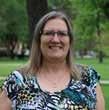

Row 1 (L-R): Abiodun Oyelami, Alejandra Coronel, Alex Rogalski, Ana Cristina Camacho, Busayo Osobade, Catherine Folstad. Row 2 (L-R): Damon Badger Heit, Dean Kush, Tara-Leigh Heslip, Diane Ell, Elizabeth Akinyemi, Gloria Walsh.
Row 3 (L-R): Jackie Ledingham, Lorelie DeRoose, Nichole Williams, Paul Gingras, Shawn Bauche, Shelley Fayant. Row 4 (L-R): Dennis Garreck (retired May 2023).
Board 2023/24









Row 1 (L-R): Christine Ruys, Heather Cline, James Ingold


Chair), Jan Seibel
Joanne McDonald, Lamarr Oksasikewiyin. Row 2 (L-R): Les Oystryk, Yvonne Hotzak, Roy Lavallee (appointed November 2023), Melanie Sunchild (resigned July 2023), Candice Evans-Waite (resigned March 2024).
(Past
(Chair),
5
Staff
SaskCulture has a Vision for a
Culturally Vibrant Saskatchewan
Vision Mission
SaskCulture strives to build a culturally vibrant future in which all people in Saskatchewan, individually and collectively, celebrate, value and support participation in, and access to, cultural experience.
Principles and Values
SaskCulture supports engagement in cultural experience.
Cultural activity / Engagement / Experiences / Revitalization
SaskCulture recognizes strength in common purpose.
Cohesiveness / Collective effort / Advocacy / Cooperation / Partnership / Volunteerism / Cultural work / Treaty peoples
SaskCulture Ends
SaskCulture works to build a culturally vibrant Saskatchewan, where…
SaskCulture unites the cultural community and works to advance the cultural vibrancy of the province.
SaskCulture provides equitable and fair access to resources.
Sask Lotteries / Transparency / Accountability / Effectiveness / Delivery / Cultural impact / Accessibility / Unique service
SaskCulture will be responsive to people within Saskatchewan.
Diversity / Inclusivity / Democratic process / Accessibility / Equity / Multiculturalism / Reconciliation
• People of Saskatchewan actively value, support and participate in culture; and
• The cultural eco-system in Saskatchewan is accessible, inclusive and sustainable.

6
Photo by Kevin Hogarth (2023).
Members say...
2023 Membership Survey
In May 2023, SaskCulture asked its 160 member organizations and individual members how they felt about some of the key issues impacting their work in cultural activity. Over half, 103 members responded, providing us with some interesting insight into who is supporting cultural activity in the province.
Members
responded
Top issues for members
68.4% (72) respondents say they offer programs for specific
First Nations/Métis peoples Under 29 years Under 29 years People with disabilities Black/People of Colour Black/People of Colour BPOC First Nations or Métis First Nations or Métis People living in the North Immigrants <10 years 2SLGBTQIA+ 2SLGBTQIA+ People living in remote areas People with disabilities Living in remote areas 2SLGBTQIA+
equity-
deserving groups
Members who are: 78.3% Funding to sustain operations 67.5% Advance IDEA 66.9% Public value/ participation 62% Truth and Reconciliation Members who currently offer programs for specific equity-deserving groups 29.2% 56.9% 56.9% 43.1% 43.1% 36.1% 38.9% 77% 54.9% 56.9% 43.1% 51%
103 respondents say they have Board
who
48.4% 48.4% 40.3% 64.8% 35.5%
are: Members likely to investmorein equity-deserving groups nextyear Slightly less Somewhat unlikely More Much less Much more 31% 49% 14.9% 25.7% 5.1% 2.7% Not very likely Somewhat likely Somewhat well Very likely 20.3% 53.6% 51.3% Really well 16.7% Not very well 5.6% Somewhat not well 24.1% Members feel they are serving Members who feel Saskatchewanis equity-deserving groups moreculturally vibrant than 10yearsago
103 respondents say they have employees who
7
Increasing effectiveness and sustainability of funding
Deeper understanding of different value-based needs, key to funding renewal
Learning how to connect to a greater diversity of people and perspectives is key to building a better funding model that will be sustainable into the future.
This past year, SaskCulture continued to move forward on the multi-year Funding Program Renewal Project, designed to ensure that dollars from the Culture Section of Sask Lotteries Trust Fund are used to benefit the people in Saskatchewan. In particular, the renewal process is focused on supporting Inclusion, Diversity, Equity and Accessibility (IDEA), advancing Truth and Reconciliation, establishing value-based evaluation and helping to ensure the sustainability of Saskatchewan’s cultural sector.
“We spent the year learning more about the impact of current funding and exploring some of the barriers to funding that need to be addressed,” says Dean Kush, CEO, SaskCulture. “At this point, we are continuing to improve our understanding of value-based evaluation options, more participatory granting processes, the challenges faced by equity-deserving groups, as well as identifying objectives for future research and consultation.”
The work over the past year included small pilot studies, performed by Reciprocal Consulting, from April to June 2023, which identified stakeholder feedback on evaluation tools, contributing to a wider framework that could be used to measure progress on inclusion, diversity, equity and accessibility, as a result of funding support. The process included a focus group and surveys of grantees, members, staff members and volunteers.
According to Catherine Folstad, Supervisor, Granting and Technology, “The results of the pilots helped us better understand the tools needed to assess stakeholder awareness and alignment with IDEA and Truth and Reconciliation in their programming, services and decisionmaking.” The pilots helped refine questions that can
be used to collect input on funding program delivery, identify ways to improve delivery processes, learn more about equitable funding practices, including barriers and enablers, as well as measuring the Board and staff’s support for change going forward.
SaskCulture recognizes the importance of helping the community learn and implement value-based evaluation practices. The Reciprocal report outlined the value of this type of data collection and analysis, as well as key policies that can be used by SaskCulture and others to ensure evaluation practices are ethical, safe, consistent and less of a burden.
“By identifying and focusing on values, we can facilitate a way for SaskCulture and potential grant recipients to communicate about a funding program’s goals and intentions, provide a critical lens for interpreting outcomes and impacts, help establish value-based measurements and ensure the program is adaptable to changing circumstances.” –Catherine Folstad Folstad also noted that, evaluation data can be used to track the impact of the funding system, as well as to help advocate for necessary changes required to address the needs of the people in Saskatchewan.
Kush adds that SaskCulture’s Funding Program Renewal Project also benefited from working with SK Arts on the Share and Connect and the Building Arts Equity: BPOC grant programs over the last year. “For both of these grants, we were able to explore and learn from the hands-on process of using participatory grant-making to become more responsive to the needs of equity-deserving
STRATEGIC PRIORITY 1 FUNDING IS SUSTAINABLE AND ADAPTABLE TO CHANGING NEEDS 8
groups,” he says. “It’s been a positive experience seeing community members be actively involved in the development and implementation of a grant program designed to meet their needs.”
As part of its learning process, SaskCulture commissioned two reports designed to identify practices that help engage and support cultural engagement and access for people with disabilities and 2SLGBTQIA+ communities. Folstad notes that, “Each of these groups face different barriers to accessing cultural funding and these reports are helping us get a better understanding of some of the systemic issues, challenges, as well as funding delivery options already in use by other funding bodies.”
Kush adds that much of the work in 2024 will focus on consulting with the wider cultural community. Over the past year, SaskCulture made progress on identifying its research objectives and establishing preliminary consultation plans. “It’s time to take some of what we have learned out to the community to get their input,” he says. “Community input, particularly from equity-deserving groups, will help us in identifying the key changes that need to take place to support an inclusive, diverse, equitable and accessible funding delivery system going forward.”
 Progress was made on building equity in arts funding by working with community partners on a new grant.
Photo by Ali Lauren, MCoS (2023).
Progress was made on building equity in arts funding by working with community partners on a new grant.
Photo by Ali Lauren, MCoS (2023).
9
Increasing access to funding
Small grant has big impact for Sounds of Afghanistan
For years, music provided an outlet for one particular Afghan refugee group to advocate for the "voiceless" women in Afghanistan. When the Taliban seized power in their country, members of the musical group Sounds of Afghanistan fled to Saskatoon in 2021. While adjusting to life in a new country, they continued to perform and look for ways to get their messages out to the wider community.
The group’s access to the Small Grant Accessibility Program (SGAP) provided them with the support to continue their role of healing and spreading their message through music. SGAP was designed to support first-time or under-served applicants undertaking unique and innovative cultural initiatives that respond to emerging needs.
Maryam Masoomi, youth program facilitator, Saskatoon Open Door Society (SODS), was part of the musical group back in Afghanistan. In her role with SODS, she initiated the revival of the music group Sound of Afghanistan, which encourages Afghan youth, mainly girls from ages 12 to 23, to use their voices, find community, and build teamwork skills.
“As you know, girls are not allowed to go to school in Afghanistan. The group wants to be a voice for other girls in Afghanistan. They also want to showcase and share their culture,” she says. “During one of the group’s performances on Canada Day, I saw their parents crying because they were so happy. The girls were so happy.”
Masoomi says the music group is Saskatchewan’s first Afghan music cultural group and has performed at the Saskatoon Folkfest, Canada Day, and other cultural events. The group’s successful application to SGAP in 2023 paved the way for further project support from SaskCulture’s Multicultural Initiatives Fund.
Fourteen-year-old Sajadia Ahmadi is one of the group’s youngest members. She says, “I really like singing. It feels so good when you introduce your culture to others and inspire them through our beautiful songs. I feel privileged when the audience gives us so many positive comments
about our performance, costumes, and beautiful culture.”
Harjeet Kaur, youth program team lead, SODS, says singing is helping the youth to heal from their experiences. “Singing brings joy and pure love, and it helps to heal,” she says. “With the extra support, we were able to purchase dresses for these participants. They loved it and flaunted it. We used some for transportation as well.”
Kaur adds that the team plans to create a dance group for younger participants. “The plan is to get the girls to mentor these younger kids. We will then loop them into the music group later. This will help with our sustainability plan.”
Since launching in 2021, the Small Grant Accessibility Program has helped over 49 new and under-served groups seeking support for their programs.
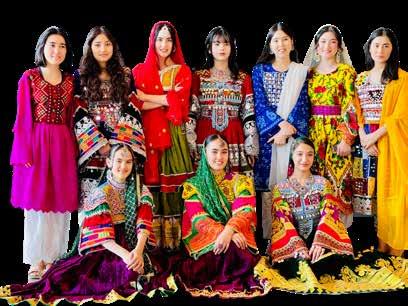
10
IS SUSTAINABLE AND ADAPTABLE TO CHANGING NEEDS
FUNDING
STRATEGIC PRIORITY 1 FUNDING IS SUSTAINABLE AND ADAPTABLE TO CHANGING NEEDS 10
The Sounds of Afghanistan group was able to bridge to other funding programs thanks to the SGAP funding. Photo courtesy of SODS.
Raising awareness for funding the arts
Report demonstrates economic impact of arts funding in Saskatchewan
People need to understand that the arts have a significant economic impact in the province. A report, released in 2023, showed that for every $1 million invested by the province, SK-Arts-funded organizations were able to leverage over $2 million from the federal government, $1.8 million from the private sector, $1.75M from the municipal government, as well as generating $1.2 million in earned revenue.
The Economic Impact of Arts Organizations Funded by SK Arts, released by Saskatchewan Arts Alliance (SAA), in November 2023, demonstrated the economic contributions made by funded arts groups. The report, based on Statistics Canada input-output multipliers, showed that for every dollar invested by the provincial government, arts organizations generated another $13.70 of economic output.
“People involved in the arts inherently understand the benefits they bring to our quality of life, but there is an ongoing challenge to articulate those benefits to others in a measurable way,” says Em Ironstar, executive director, SAA. “This is something that we needed to be able to accurately talk about... what the arts and culture contribute to the economy of our province.”
The SAA decided to develop the economic impact report to help assist in advocating for increased resources for the arts, says Ironstar. Many arts organizations continue to face financial struggles and more discussions are needed to demonstrate the value of investment in the arts.
“Without those investments at every level, from federal funding to private sector funding, an arts organizations’ ability to leverage additional dollars is really weakened,” Ironstar says.
Since its publication, the SAA has been bringing the report to MLAs across the province, using the data as a starting point to build new relationships with government officials. “We’ve had really meaningful conversations that start from a common starting point of economic impact,” Ironstar says. Going forward, there are plans for SAA to continue building these relationships across the province as part of its advocacy work, aided by further research into the economic impact of the arts.
“It is really important to invest in these arts organizations and experiences, and in the cultural life of our province,” Ironstar says. “This research is building the tools that we need to have these conversations.”
$2,060,045.21 $1,758,164.49 $1,856,854.48 $1,265,850.96 Revenue generated per $1 million invested Federal government Municipal government Private sector Earned revenue STRATEGIC PRIORITY 1 FUNDING IS SUSTAINABLE AND ADAPTABLE TO CHANGING NEEDS From: Revenue generated: 11
Helping children and youth access cultural activities
Former Creative Kids recipients now champions for cause
When Cole Knutson was a child, he received Creative Kids support to pursue saxophone and piano lessons. Today, he is one of several former funding recipients who have stepped forward, eager to tell how they benefited from cultural activity and support from Creative Kids.
Since its formation in 2010, Creative Kids has helped support thousands of children and youth, who faced financial and social barriers, access meaningful ongoing arts and cultural activities. By providing grants of up to $750 per kid, it makes a difference. The program appreciates hearing from former recipients who, after receiving this support at an early age, see it as contributing to their success.
Now a successful professional musician, Knutson reached out to ask if he could give back by sharing his story. “The Creative Kids funding literally changed the course of my life. I developed skills that helped me deal with adversity. I gained a sense of belonging and I found my purpose,” he says. “I have had the distinct pleasure of living a rich life as a musician. My life has been so greatly enriched by such beautiful people, travels, experiences, and music.”
Over the past decade, Knutson was awarded a number of scholarships that have allowed him to study abroad at prestigious music schools and perform at venues around the world, such as Carnegie Hall. He says, none of it might have been possible if it weren’t for the support from Creative Kids, which enabled him to explore his many artistic curiosities and grow as a musician.
Brianna Dash, another Creative Kids recipient, was also eager to share her story. Dash became the first in Canada to complete the Advanced Solo Award Ballet exam, the highest ballet level within the Canadian Dance Teachers’ Association (CDTA). She attributes the support from Creative Kids, along with the skills she developed from her dance experience, as key to her success. She adds that learning to set goals and maintaining the discipline to achieve them are benefits of her dance instruction.
“Thanks to the Creative kids support, I was able to take so many different classes,” says Dash. “My passion for
dance grew, as did my skills as a dancer and I was able to achieve this goal.” Dash credits her long-time dance teacher Melissa Wallace, owner of The Dance Studio of Swift Current, for her dance training and for helping her access Creative Kids.
Youth participation in cultural activities leads to many long-term benefits. According to Gloria Walsh, manager, Creative Kids, “Cole and Brianna’s stories echo what the research on the benefits of arts and cultural activities has shown for years. When kids are able to participate in dance, theatre, music, art and cultural activities, it leads to successful milestones in adulthood.”
In 2023, Creative Kids was able to support 1,313 more kids. “Unfortunately,” says Walsh,” due to limited funds, we were unable to fund an additional 508 deserving kids.”
Walsh adds, “Thanks to Cole and Brianna sharing their stories, donors and sponsors may be inspired to give when they see why program costs should never be a barrier to getting kids involved with a cultural or creative activity of their choice.”
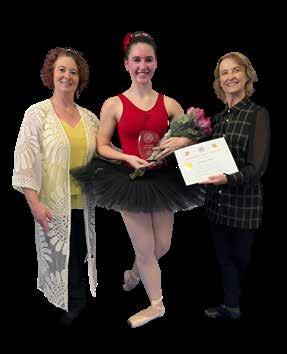
10
Brianna Dash (middle) says the Creative Kids funding helped her maintain her dance training, which led to her success.
STRATEGIC PRIORITY 1 FUNDING IS SUSTAINABLE AND ADAPTABLE TO CHANGING NEEDS 12
Photo courtesy of Melissa Wallace.
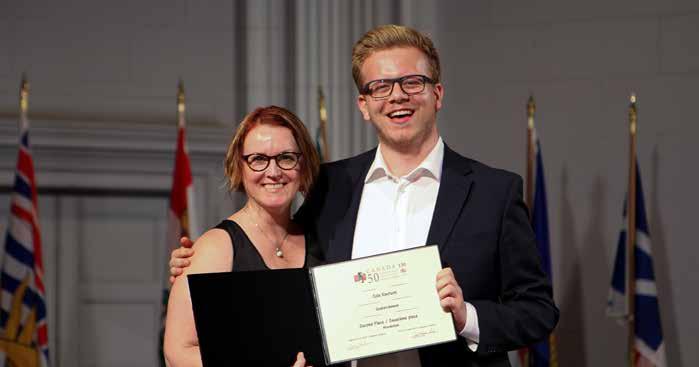
Increasing funding
Our impact since 2010
266 Communities supported
13,902 Applications funded $6.66 Million granted 598
5,979 Facebook followers

Help us meet the need of every deserving child or youth by providing them with the opportunity to creatively engage their minds. Make a donation at CreativeKidsSask.ca or call toll free 1-855-277-9469.
Music, dance, theatre, art, and cultural instructors paid
Successful musician Cole Knutson (right) stepped forward over this past year wanting to give back to the charity that opened up opportunities for him when he was most in need.
13
Photo courtesy of Cole Knutson.
Supporting sustainability of community culture
Culture 365: Enjoying cultural experiences year-round
Highlighting cultural activities all year-round is a great way to keep people engaged. Culture 365, a nation-wide initiative linked to Culture Days, was launched in Yorkton to increase the engagement of residents in the cultural life of its community. Who wouldn’t want to celebrate Culture Days all year long?
Culture 365 was identified nationally as a means to keep Culture Days going throughout the year. Culture Days, held annually, encourages people to engage in free, interactive cultural activities held in communities across the country. In 2023, Culture Days in Saskatchewan, coordinated by SaskCulture, connected over 45,000 people to 295 cultural experiences in 45 communities scattered throughout the province, over a period of three weeks. Some communities, such as Yorkton, adopted Culture 365 to keep the celebration going.
“The question came up, ‘Why don’t we do this all year? Why does it have to be just those three weeks between September and October?’” says Lisa Washington, manager, community culture and heritage, City of Yorkton. “We also want to send the message that cultural activities and their benefits are available yearround and encourage people to support the artists and creators in their communities.” The initiative evolved from conversations with community artists and creators involved in Culture Days.
The first Culture 365 event, Jamaican Cooking Class, held January 24, 2024 was hosted by 306 Nyammings, engaged community members in the tradition of authentic Jamaican cuisine. Taynika Walker, one of the company’s founders and class facilitator, taught participants how to make fried green plantain, known as Tostones, served with corned beef and sweet corn. Washington says the class was well received by participants, “opening people’s awareness and taste buds with different cooking styles.” She says that exploring traditional cooking techniques
helps others, “see things from a different point of view and it's a great way to learn about other cultures.”
In addition, Angelina Kardynal facilitated a needle-felting class in February 2024 and plans are underway for a macro-photography class facilitated by Shannon Erickson, as well as a henna painting class. So far, the activities have been popular. Washington says, “The cooking and needlefelting classes had 20 participants each, and the seats sold out quickly.”
She says there are plans to organize online arts or culture activities for people who cannot attend the classes in person.
SaskCulture continues to lead Culture Days Saskatchewan each year. It offers Culture Days Hub Sponsorships that support communities such as Yorkton. Washington appreciates SaskCulture’s support of Culture Days in Saskatchewan. She encourages communities to delve deeper into cultural activity that exists in the community, as well as the individuals involved. “There are artists who can teach about their own cultures—think of Culture Days as a celebration of who is in your community, not what is in your community.”
 Yorkton residents learned how to make Jamaican cuisine as one of the Culture 365 events held throughout the year. Photo courtesy of Culture Days Yorkton.
Yorkton residents learned how to make Jamaican cuisine as one of the Culture 365 events held throughout the year. Photo courtesy of Culture Days Yorkton.
STRATEGIC PRIORITY 1 FUNDING IS SUSTAINABLE AND ADAPTABLE TO CHANGING NEEDS 14
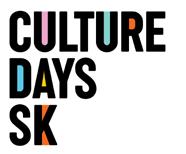
31
20
Hubs sponsored participated digitally and in-person registered activities offered in-person, online and outdoors attended National Day for Truth and Reconciliation events attended in person
100,000+
10,000 Est.
About Hubs focused on Truth and Reconciliation 2023
295+
45,000 Est.
The 2023 Culture Days Hub Sponsorship recipients
City of Prince Albert
Melfort and District Museum
City of Yorkton
City of Swift Current
Nutrien Wonderhub (Saskatoon)
Town of Porcupine Plain
Oxbow & District Recreation Board
Art Gallery of Regina Last Mountain Lake Cultural Centre
Nuit Blanche (Saskatoon)
The Reading Place (Battleford)
Saskatchewan Craft Council (Saskatoon)
City of Lloydminster
Town of Lumsden
City of Weyburn
Grand Coteau
Heritage & Cultural Centre (Shaunavon)
Town of Gull Lake
Sri Lankan Association of Regina Inc.
Town of Assiniboia
Town of Carrot River
Willow Bunch Museum & Heritage Society Inc.
Regina Public Library
RISE UP Community Advisory Foundation
Silton Recreation Board
Village of Hazlet
Beauval Minor Sports and Recreation
City of Humboldt
Climax Community Museum
Meadow Lake Library
Listen to Dis’ Community Arts Organization Inc.
Free Flow Dance Theatre Inc.
$98,440 in support
15
Strengthening capacity-building for growing organizations
AFCS helps local Centres address capacity for cultural programming
In recent years, many Aboriginal Friendship Centres in the province saw unprecedented growth and demand for more culturally relevant programming. To help support this growth, the Aboriginal Friendship Centres of Saskatchewan (AFCS), worked with these centres to offer different capacity-building initiatives designed to help support staff in delivering meaningful cultural programming and services to their large and diverse communities.
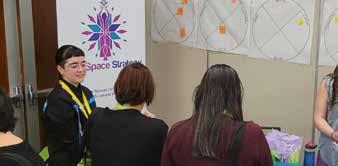
According to AFCS, Aboriginal Friendship Centres remain integral for Indigenous people in Saskatchewan who have moved from reserves to urban areas as they provide a sense of cultural identity, safety, and community engagement. Important gathering spaces, these centres offer a wide range of programs and services tailored to meet the diverse needs of urban Indigenous populations, supporting physical, mental, cultural, spiritual well-being, and intellectual development.
“It’s very precious,” says Morgana Machea, manager, Safe Space Strategy, AFCS, of the role of Friendship Centres. “It’s the place to reconnect with your culture or to practice your culture. There are many generations of folks who still rely on Friendship Centres to have that connection.” AFCS, which receives Annual Global Funding from Sask Lotteries Trust Fund, serves as their advocate, support system and collaborator to help build capacity among centres to deliver culturally responsive programming.
Alicia Buckley, program director, AFCS, says that AFCS actively engages with urban Indigenous communities to identify and address their needs through evidence-based research and community consultations. “We’re seeing policy changes and public awareness changes that are really changing the way we address urban Indigenous people,” she says. This process helps identify programming priorities.
The AFCS currently focuses on supporting different types of cultural capacity-building programs, such as Cultural Humility Training, which raises awareness of the barriers and the issues that Indigenous peoples face when accessing services. Cultural Humility Training was originally offered to over 1,800 staff of the Saskatchewan Health Authority. The one-day course, featuring Saskatchewan-focused information, is currently available to the public.
Other capacity-building programs offered through AFCS include, “Honouring Her Spark” which supports Indigenous women’s and 2SLGBTQIA+ individuals’ economic empowerment, and a Safe Space Strategy, currently in development with partners from the Sexual Assault Services of Saskatchewan and OUTSaskatoon, aimed to address gender-based violence on Indigenous women and 2SLGBTQIA+ individuals.
AFCS expanded from two employees in 2018 to 12 full-time permanent staff members this past year. Its work enables cultural leadership and connections essential to supporting inclusion, equity and accessibility, as well as advancing Truth and Reconciliation in different ways.
As AFCS continues to expand as an organization, Buckley says the organization’s growth reflects a commitment to diverse representation and inclusivity in the workplace, which mirrors the welcoming nature of Friendship Centres to individuals of all backgrounds. “We welcome anyone and everyone. There is a reason why ‘Friendship’ is in the name of Friendship Centres.”
STRATEGIC PRIORITY 1 FUNDING IS SUSTAINABLE AND ADAPTABLE TO CHANGING NEEDS 16
Aboriginal Friendship Centres of Saskatchewan addressed capacity-building through the development of new initiatives, which strengthened their programs. Photo courtesy of AFCS.
Improving process for volunteers
Online Grant Platform improves user experience for assessors
Determining how grant funding is distributed involves reviewing multiple applications, evaluating each against grant criteria, as well as meeting and discussing as a panel before making final decisions. New updates to SaskCulture’s Online Grant Platform (OGP) were made this year to make this process much easier and accessible for volunteer assessors.
The updates to the Assessor Portal of the OGP were identified from feedback collected from past assessors hoping to improve their experience. New features included tools to keep tabs on application scores and to increase access to relevant documents and different parts of the application.
“The goal was for clear, intuitive access to information,” says Catherine Folstad, supervisor, Granting and Technology, SaskCulture. “The OGP is already fairly userfriendly, but when using the system for grant applications that have large amounts of data and information, we wanted to use technology as a meaningful resource.”
Increasing the efficiency of the portal and decreasing the time needed to learn how to use the system is a priority. Volunteering as a peer assessor can be a significant time commitment, so the system needs to support rather hinder the work.
“Volunteers are busy. So anything we can do to help them with the process helps to ensure volunteers are satisfied and have a positive experience with SaskCulture,” says Folstad, “And, help ensure that they will want to come back and volunteer again in the future.”
Another recent addition to the OGP is an accessibility widget that lets all users change the display features to change font, size, spacing, contrast and more. This feature makes it possible for users to address their individual needs and preferences. This addition is one step towards enhancing accessibility on the OGP.
As for future updates to the platform, Folstad says that there are many priorities for the year ahead, including continuing to add more flexibility into the system to help support different formats of funding delivery, such as use in participatory grant-making.
As for the Assessor Portal, SaskCulture will continue to adapt to make sure technology is an asset for all volunteers. “Volunteers are important to SaskCulture and the peer assessor process is pretty special — assessors are volunteers, giving back to the community by being part of the funding process.”
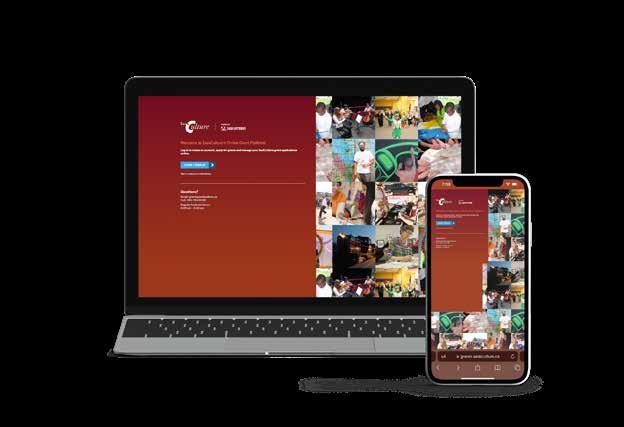 Improvements to the Online Grant Platform (OGP) provide volunteer assessors increased access to information needed for assessing SaskCulture grant applications.
Improvements to the Online Grant Platform (OGP) provide volunteer assessors increased access to information needed for assessing SaskCulture grant applications.
STRATEGIC PRIORITY 1 FUNDING IS SUSTAINABLE AND ADAPTABLE TO CHANGING NEEDS 17
Increasing equity, leadership and accessibility
By us for us: Innovation towards equity in arts funding
The new Building Arts Equity: BPOC (Black and People of Colour) Program was specifically designed by and for artists of colour who have been marginalized and excluded from arts funding. The inclusive and equitable program design, resulted in many new first-time applicants and another success with the participatory grant-making process.
Leading up to this point, SK Arts and SaskCulture, in partnership with the Multicultural Council of Saskatchewan (MCoS), brought together artists from African, Black, Asian, Latin American and Middle Eastern descent in Saskatchewan to develop a grant program that would best meet their funding needs and eliminate identified barriers to access. These consultations, part of the participatory grant-making process, led to the development of a grant program designed for these communities, by these communities.
“When we take direction and listen to the people who are experts in their cultures and their arts practice, we find out how to best support them,” says Damon Badger Heit, supervisor, Partnership and Inclusion, SaskCulture. The partners were involved in the creation of the Share and Connect grant in 2022 that used a participatory grant development to ensure more funding was accessible by Indigenous artists. “It creates a reciprocal relationship that we can continue to refine and improve. Community-led solutions build accessibility, equity and opportunities for arts activities that are truly informed by all the cultures present in Saskatchewan.”
He says, when equity-deserving communities are consulted through a participatory grant-making process, their needs are bettered identified and it results in empowered solutions. The consultations identified a number of ways to better support artists of colour in Saskatchewan, such as mentorship opportunities, support for newcomers to find and apply for the grant, the need for authenticity of expression in their own culture and art, community-led knowledge transfer, as well as increased recognition, value, and respect for the diversity of the BPOC community.
Organizers acknowledge that using the acronym BPOC, to recognize people of African, Black, Asian, Latin American, Caribbean and Middle Eastern descent, is an imperfect term that is not agreeable to all who are involved in this process. Using a name or acronym to identify numerous distinct cultures is challenging. While BPOC is currently being used for this program, all partners will strive to identify specific peoples involved where possible.
Chancz Perry, program consultant, diversity and inclusion, SK Arts, says, the first round of funding had 33 applicants and successfully met some of the aims identified through the consultations. “Because this funding program focuses on BPOC people, it creates an invitation for people who might normally not know, or not normally apply,” he says. “It encourages them to pursue funding so that they can create and develop new work that can be traditional, contemporary or nontraditional.”
At the first allocation, artists of colour that applied were able to connect with others from their artistic and cultural communities, as well as, artists from other ethnocultural communities, which provided opportunities of learning, mentorship and empowerment. As a result, 14 artists received funding from this program, and applicants had the opportunity to be involved in assessing their peers proposed projects. Perry adds that, “As a result of the applicants having access to many other applications through the assessment process, they saw some of the strengths in other people's writings. Learning how other artists approached writing the grant helped them to see how they could improve their own application the next time they applied.”
STRATEGIC PRIORITY 2 IMPROVE INCLUSIVENESS, DIVERSITY, EQUITY & ACCESSIBILITY OF CULTURAL ACTIVITY
18
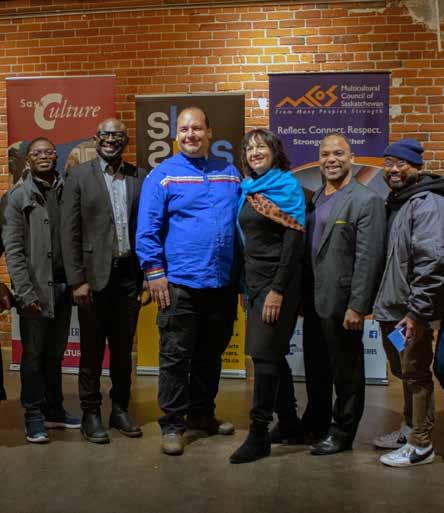
Aster Ghebermicael, an applicant and assessor for the first round of funding, says she was surprised when she discovered a grant that she could apply to based on her cultural heritage. “I didn't think there would be a grant for someone just like me,” she says. ”I loved to see that there is this movement of welcoming other cultures to show their artistic side, as I feel like we all want to be seen and heard. I had such a huge network of artists open up to me that are willing to mentor and help me out the next time I apply. It was such a learning journey.”
Rhonda Rosenberg, executive director, MCoS, says “I am excited to learn from Building Arts Equity and I hope to see other grant programs, in our own organizations and beyond, implement approaches based in collaborative relationships and equity to address barriers related to racism and oppression.”
The Building Arts Equity program brought together artists of colour from African, Black, Asian, Latin American, Caribbean and Middle Easter descent to create a funding program that met their needs. Photo courtesy of SaskCulture.
19
Increasing learning opportunities for community
New ideas for cultural leaders
Effectively leading a cultural organization requires an openness to change and growth. There are always new ideas, topics and leading practices waiting to be explored. This past year, SaskCulture offered members and others in the community several learning sessions on topics of interest. These online Lunch and Learn sessions were designed to provide cultural leaders with a quick introduction to emerging topics, along with ideas they could immediately put into practice.
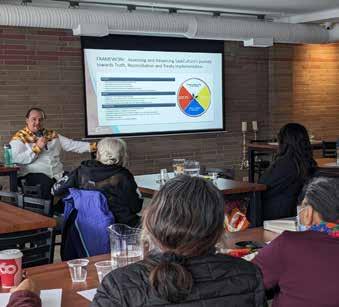
In November 2023, SaskCulture offered Financial Health & Sustainability for Non-Profits presented by James Barr and Diana Leray, from KPMG. The session covered how board members should review an organization’s financial statements and how to understand risks such as the potential misuse of funds or failure to adhere to laws and regulations. Different types of fraud, such as funding fraud, embezzlement and vender fraud, were discussed along with important systems of control.
In December 2023, cultural leaders were invited to attend Artificial Intelligence (AI): Myths, Needs, and Opportunities, presented by Amy Sample Ward, CEO, NTEN. Participants learned about AI, its current uses, as well as its potential to support work processes. The session focused on developing equitable practices and sound policies to guide the use of AI in organizations, as well as efforts to eliminate bias in results.
In January 2023, SaskCulture’s Communication Manager Diane Ell presented on Strengthening Your Social Media Marketing in 2024. This session focused on ways non-profit cultural organizations could build their organization’s social media presence by developing a strategy, effectively using tools, and designing and sharing value-added posts for intended target audiences.
Later in February 2023, SaskCulture offered Intro to Cultural Humility Training presented by Melody Wood, of Aboriginal Friendship Centres of Saskatchewan (AFCS). The presentation provided an overview of the training program offered by AFCS designed to help participants gain knowledge and tools/techniques to create and offer culturally safe and inclusive programs and services for racialized and marginalized communities. Originally developed for use in the health-care sector, the program has been redeveloped by AFCS into a three-hour session of interest to the wider community.
By fiscal year-end, SaskCulture was already planning more sessions for the upcoming year, including a session on Governance to be presented by Dawn Martin. Other topics identified in the 2023 Member Survey are being explored.
SaskCulture continues to offer learning opportunities to the cultural community that explore new ideas to support changing needs.
STRATEGIC PRIORITY 2 IMPROVE INCLUSIVENESS, DIVERSITY, EQUITY & ACCESSIBILITY OF CULTURAL ACTIVITY 20
Photo by Alex Rogalski, SaskCulture.
Building cross-cultural understanding
Fostering a deeper understanding of Reconciliation for newcomer youth
Interested in addressing Truth and Reconciliation, the Regina Open Door Society (RODS) remains committed to offering programming designed to help newcomer youth gain a deeper understanding of the injustices faced by Indigenous peoples. By acknowledging the past in an inclusive way, the engagement sessions, led by local Indigenous leaders, helped to break down stereotypes and promote respect for Indigenous identities and perspectives.
The Youth Indigenous Education program, developed by RODS, offers an immersive and inclusive learning environment that furthers newcomers’ understanding of the land they now call home. The INVOLVE program, focused on Integrating Newcomers with Volunteer Opportunities to add Leadership Value through Education, includes handson workshops, led by Indigenous community members, to ensure that the work of Reconciliation can be put into action. Both programs have received support from the Multicultural Initiatives Fund over the years.
“Sometimes people who are new to this place might have preconceived notions or opinions about Indigenous people that may not be correct,” says Joely BigEagle, an interdisciplinary artist and the co-founder of Buffalo People Arts Institute, who helped facilitate the sessions. “So it is important for there to be a point of connection to share the truths about how Indigenous people shaped and influenced Saskatchewan and Canada, as the original peoples.” She appreciated the opportunity to share her creativity and culture with these newcomer youth, while being a positive role model from the community.
Participants in the sessions learned about the history and inter-generational impact of the residential school system and other colonial policies on Indigenous peoples and communities. According to Zuhal Latif, team leader, Welcoming Community For Newcomers, “Learning about these historical injustices is crucial for recognizing their ongoing impacts and the need for Reconciliation. [The engagement sessions] are able to provide participants with skills and strategies for engaging with Indigenous communities in respectful and meaningful ways.”
The sessions have included a variety of hands-on learning opportunities such as field trips to Wanuskewin, Indigenousled cooking classes, as well as attending pow wows around the community. Latif says that, while there can be struggles to appropriately address some of the more complex issues of colonization, RODS has expressed a feeling of pride in fostering respectful and meaningful connections between Indigenous and newcomer populations.
As for BigEagle, she feels the cultural-sharing and knowledge exchange has led to incredibly positive outcomes. “I loved working with the youth from other countries. Even though they may have had various issues of why they had to leave their country, they were all very positive youth, eager to learn and be engaged in the activities.”
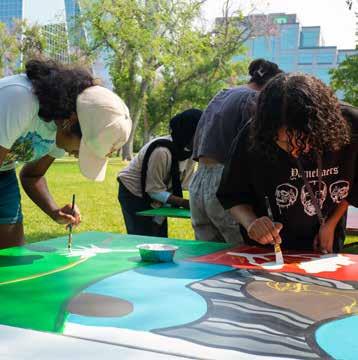
STRATEGIC PRIORITY 2 IMPROVE INCLUSIVENESS, DIVERSITY, EQUITY & ACCESSIBILITY OF CULTURAL ACTIVITY 21
Newcomer youth had the opportunity to gain a deeper understanding of Indigenous experiences and perspectives through programming from the Regina Open Door Society. Photo courtesy of RODS.
Increasing
preservation of Northern languages
Northern community uses art and technology in language revitalization project
Visual artist, Michéle Mackasey has always felt strongly about the importance of language. In 2023, she knew her next art project would have to somehow advance language revitalization in an inclusive and accessible way that would give youth and their families the opportunity to learn by using a hands-on approach.
After seeing online interactions that utilized the Dene language on social media platforms, she decided on an art project that would further develop how the Dene language could be more easily communicated by using technology. The project was part of the Northern Languages Program funded through the Northern Youth Cultural Fund, and led with the support of local Elders and educators.
“As a French speaker who grew up with the privilege of plenty of access to my language, you begin to wonder why it isn’t a ‘right’ for Indigenous communities to continue to learn, read and write in their own language to keep that language alive.” She has been visiting the Denesuline communities of English River First Nation, Patuanak, Beauval, and the nearby Métis community of Île-à-la-Crosse, for nearly three decades.
To help support the technological elements, Mackasey involved her son Ezaneh with the project. “The prospect of combining modern technology with traditional knowledge
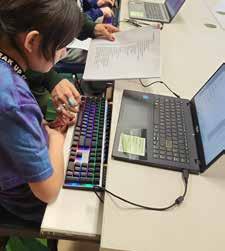
to support language learning and cultural exchange was incredibly compelling to me,” he says. “It’s about creating bridges between generations and facilitating conversations that might otherwise have been lost.” His experience in keyboard development and creation, as well as a strong desire to keep his Denesuline language alive was the driving force for creating the world’s first Dene language keyboard for the project.
“By integrating Dene language keyboards into our digital strategy, we empower future generations to actively connect with their cultural roots, ensuring that the Dene language remains a vibrant and integral part of daily life,” says Ezaneh.
According to Mackasey, the art project was inspired by a photograph of a young woman who died in the community’s residential school in her early teens due to medical neglect. Mackasey used the photograph to guide community conversations. “This is the irreparable damage that has been caused to multiple generations in so many communities and families and individuals,” she says.
The project included many phases and steps, involving a wide range of age groups. She has encouraged the youth involved to use the language keyboards to write messages inspired by the photograph in their Denesuline languages. These messages will eventually be engraved onto an estimated 17,000 tiny bottles, which will then be meticulously put together as a large-scale replica of the photograph of the young woman. According to Mackasey, the idea is to both acknowledge and process the past, while also carrying the Denesuline language into the future.
Youth in northern communities learned to communicate thanks to the development of the world’s first Dene language keyboard. Photo courtesy of Mackasey.
STRATEGIC PRIORITY 2 IMPROVE INCLUSIVENESS, DIVERSITY, EQUITY & ACCESSIBILITY OF CULTURAL ACTIVITY 22
Increasing involvement in cultural experiences
Back to Batoche gets record attendance in 2023
Looking out from the mainstage at the 2023 Back to Batoche festival, Dean Smith, a Prince Albert fiddle player, says he saw more people than he had ever seen on the dance floor.
“I’ve never seen a dance floor that big with that many people. The memory will stick with me forever,” he says. “It was incredibly powerful and I think this year’s going to be just as big.” Smith, who, along with his band, has played old-time dance tunes at Back to Batoche for several years, was moved by to see the dramatic increase in attendance over past years.
Back to Batoche Days, an annual festival celebrating Métis culture and heritage, has been held every third week in July since 1970. Over 40,000 people, double the amount in 2022, attended the 2023 festival—the highest attendance since prior to the COVID-19 pandemic. Held in Batoche, the historic site of the 1885 Northwest Resistance, the festival usually draws great numbers of both locals and tourists.
According to Kristi Ross, manager, Culture, Heritage and Language, Métis Nation–Saskatchewan, the strong turnout in 2023 was due to efforts to make space for people of all ages and backgrounds—youth, Elders, veterans, Indigenous and non-Indigenous—to connect with the culture and celebrate their identity. “When people come out to the Batoche festival,” she says, “they feel well taken care of. When you step foot on the grounds, you feel like you’re back at home, you feel like you’re with your family and with your friends.”
Themed the ‘Year of the Youth’, the 2023 event was designed to engage more young people. “They are our

next leaders,” says Ross, “We need to honour them now so that they will want to step into important leadership roles when they’re older.” To attract a younger crowd, the event featured jigging demonstrations, a family movie night, a DJ, and the first-ever Mrs. and Mrs. Batoche. Youth admission was also free, something that will continue in 2024.
The event attracts a diverse and wide-spread audience. From locals, such as Dean Smith whose family has homesteaded in the area for years, to tourists from as far away as Texas, Germany and Australia, as well as featured dignitaries such as chiefs from surrounding First Nations and Premier Scott Moe.
Ross expects 60,000 people to attend the 2024 Back to Batoche Days, taking place July 18 to 21. “We never turn anyone away,” says Ross. “We want everybody to feel welcomed and included because Batoche is such a powerful place to be.”

STRATEGIC PRIORITY 2 IMPROVE INCLUSIVENESS, DIVERSITY, EQUITY & ACCESSIBILITY OF CULTURAL ACTIVITY
Back to Batoche Days saw the highest attendance rate since before the pandemic. Photos courtesy of Métis Nation–Saskatchewan.
23
Increasing equity, leadership and accessibility
Exploring a shared delivery model strengthens funding programs
After three years, partners have found the shared delivery of key funding programs increased reach to equity-deserving communities and strengthened the funding process for all.
Since 2021, SaskCulture has partnered with Gabriel Dumont Institute (GDI) to offer the Métis Cultural Development Fund (MCDF), and with the Northern Sport, Culture and Recreation District (NSCRD) in the delivery of the Northern Youth Cultural Fund (NYCF). Since they were formed, these partnerships have resulted in increased uptake, increased leadership, increased access to more diverse cultural programming and a better ability to identify barriers to funding in the communities they serve.
“We realized organizations closest to the communities we are trying to serve are best to lead,” says Damon Badger Heit, supervisor, Partnerships and Inclusion, SaskCulture.
“The shared delivery model allows each partner to bring their strengths to the table. These partnerships support success in ways SaskCulture cannot accomplish on its own.” – Damon Badger Heit
Badger Heit noted that the success of the shared delivery approach was identified in its partnership with Saskatchewan Indigenous Culture Center (SICC) on the federally funded Aboriginal Languages Initiative back in 2017-2019.
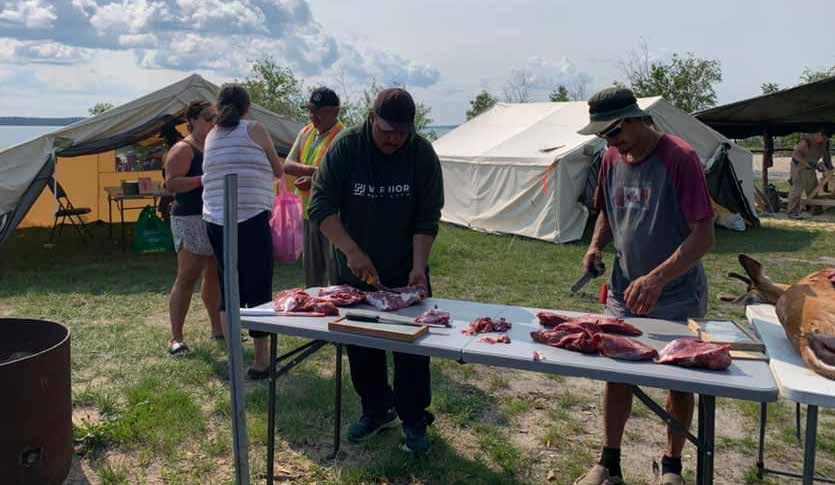
STRATEGIC PRIORITY 2 IMPROVE INCLUSIVENESS, DIVERSITY, EQUITY & ACCESSIBILITY OF CULTURAL ACTIVITY 24
Over 800 people attended the Île-à-la-Crosse Family Wellness / Cultural Camp this past year, funded through the Métis Cultural Development Fund. Photo courtesy of Île-à-la-Crosse Friendship Centre.
David Morin, Métis Culture and Heritage, GDI says, he appreciates that SaskCulture recognized GDI was in the best position to act as a “bridge” for administering the Métis Cultural Development Fund. “GDI is a trusted organization in the Métis community, actively promoting Métis culture,” he says. “The Métis community is comfortable reaching out to us and know that we do all we can to support their ideas and help them effectively deliver their programming."
“Also, in response to Reconciliation, we feel it is important that the Métis voice be included in the delivery of programs and that SaskCulture knew GDI can be that voice.”
Ryan Karakochuk, program manager, NSCRD says SaskCulture also recognized the strengths of the Northern District. “We have the ability to make the key connections on the ground in northern communities and link their arts and cultural program ideas with this funding opportunity to fulfill some of their wants and needs in the community.”
Morin adds that, this way of granting also creates better communication, as well as supporting changes to address barriers to the grant process. “For example, we advocated for a change to 100 per cent funding of activities,” he says, “as we found many organizations had difficulties in fundraising a portion of a program’s budget.” He says many successful projects took place this past year, such as the Île-àla-Crosse Friendship Centre’s Family Wellness/Cultural camp, which had 800 people in attendance.
Thanks to the partnership in the North, there are more opportunities for arts and cultural activity, as well as other benefits. Karakochuk says that, “We have seen many leaders in the community step up and apply for this funding, not only because it’s their role in the community, but because they are passionate about culture in the community and the traditions of the Elders in the past. They want to pass along those traditions and teachings with today’s youth.”
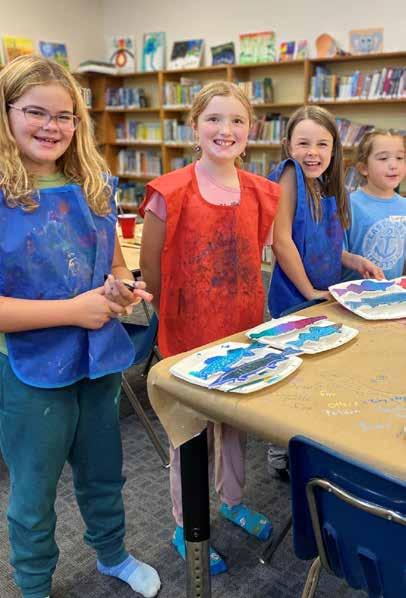 Thanks to the partnership with NSCRD, more northern youth have options for participation in culturally relevant activities.
Photo courtesy of the La Ronge Library.
Thanks to the partnership with NSCRD, more northern youth have options for participation in culturally relevant activities.
Photo courtesy of the La Ronge Library.
25
MANAGEMENT'S RESPONSIBILITY INDEPENDENT AUDITORS’ REPORT
To the Members of SaskCulture Inc.:
Management is responsible for the preparation and presentation of the accompanying financial statements, including responsibility for significant accounting judgments and estimates in accordance with Canadian accounting standards for not-for-profit organizations. This responsibility includes selecting appropriate accounting principles and methods and making decisions affecting the measurement of transactions in which objective judgment is required.
In discharging its responsibilities for the integrity and fairness of the financial statements, management designs and maintains the necessary accounting systems and related internal controls to provide reasonable assurance that transactions are authorized, assets are safeguarded and financial records are properly maintained to provide reliable information for the preparation of financial statements.
Independent Auditors’ Report
The Board of Directors is composed of Directors who are neither management nor employees of SaskCulture. The Board is comprised of community volunteers elected by the membership who review the financial statements in detail with management prior to their publication. The Board is also responsible for recommending the appointment of SaskCulture's external auditors.
To the Members of SaskCulture Inc.: Opinion
To the Members of SaskCulture Inc.:
Opinion
The summary financial statements, which comprise the summary statement of financial position as at March 31, 2024, and the summary statements of operations for the year then ended, and related notes, are derived from the audited financial statements of SaskCulture Inc. for the year ended March 31, 2024.
In our opinion, the accompanying summary financial statements are a fair summary of the audited financial statements, in accordance with the basis described in Note 1.
Summary Financial Statements
The summary financial statements do not contain all the disclosures required by Canadian accounting standards for not-for-profit organizations. Reading the summary financial statements and the auditor's report thereon, therefore, is not a substitute for reading the audited financial statements and the auditor's report thereon. The summary financial statements and the audited financial statements do not reflect the effects of events that occurred subsequent to the date of our audit report of the audited financial statements.
The Audited Financial Statements and Our Report Thereon
We expressed an unmodified audit opinion on the audited financial statements in our report dated May 10, 2024.
The summary financial statements, which comprise the summary statement of financial position as at March 31, 2024, and the summary statements of operations for the year then ended, and related notes, are derived from the audited financial statements of SaskCulture Inc. for the year ended March 31, 2024.
Management’s Responsibility for the Summary Financial Statements
In our opinion, the accompanying summary financial statements are a fair summary of the audited financial statements, in accordance with the basis described in Note 1.
MNP LLP is appointed by the members to audit the financial statements and report directly to them; their report follows. The external auditors have full and free access to, and meet periodically and separately with, both the Audit Committee and management to discuss their audit findings.
Summary Financial Statements
May 10, 2024
Management is responsible for the preparation of the complete financial statements in accordance with the basis described in Note 1.
Auditor’s Responsibility
The summary financial statements do not contain all the disclosures required by Canadian accounting standards for not-for-profit organizations. Reading the summary financial statements and the auditor's report thereon, therefore, is not a substitute for reading the audited financial statements and the auditor's report thereon. The summary financial statements and the audited financial statements do not reflect the effects of events that occurred subsequent to the date of our audit report of the audited financial statements.
The Audited Financial Statements and Our Report Thereon
We expressed an unmodified audit opinion on the audited financial statements in our report dated May 10, 2024.

Dean Kush, CEO
Management’s Responsibility for the Summary Financial Statements
Management is responsible for the preparation of the complete financial statements in accordance with the basis described in Note 1.
Auditor’s Responsibility
Our responsibility is to express an opinion on whether the summary financial statements are a fair summary of the audited financial statements based on our procedures, which were conducted in accordance with Canadian Auditing Standards (CAS) 810, Engagements to Report on Summary Financial Statements.
Regina, Saskatchewan May 10, 2024
Our responsibility is to express an opinion on whether the summary financial statements are a fair summary of the audited financial statements based on our procedures, which were conducted in accordance with Canadian Auditing Standards (CAS) 810, Engagements to Report on Summary Financial Statements.
Regina, Saskatchewan
May 10, 2024

Chartered Professional Accountants
Chartered Professional Accountants
LLP - Regina - 2010 - 11th Avenue
26
SaskCulture Inc.|Summary Statement of Financial Position As at March 31, 2024
March 31, 2024
Assets
SaskCulture Inc.|Summary Statement of Operations For the year ended March 31, 2024
March 31, 2023
March 31, 2022 March 31, 2023
Approved on behalf of the board


Director
SaskCulture Inc.|Note to the Summary Financial Statements For the year ended March 31, 2024
1. Basis of the summary financial statements
Management has prepared the summary financial statements from the March 31, 2024 audited financial statements, which are in conformity with the Canadian accounting standards for not-for-profit organizations. The audited financial statements can be obtained from SaskCulture Inc. The detailed notes included in the audited financial statements are not included in these summary financial statements.
The criteria developed by management for the preparation of the summary financial statements is as follows: that the information included in the summary financial statements is in agreement with the related information in the complete financial statements, and that the summary financial statements contain the information necessary to avoid distorting or obscuring matters disclosed in the related complete
including the notes thereto, in all material respects.
financial
statements,
Cash and short-term investments 2,460,366 2,895,837 Accounts receivable - 23,527 Prepaid expenses and deposits - 2,840 GST receivable 8,564 12,744 2,468,930 2,934,948 Intangible Assets 80,183 138,182 Capital Assets 123,950 116,595 2,673,063 3,189,725 Liabilities Accounts payable and accruals 160,695 111,518 Due to Sask Lotteries Trust Fund – Operations 300,366 500,089 Holdbacks payable 379,847 837,624 Due to Sask Lotteries Trust Fund - Programs 207,852 290,515 1,048,760 1,739,746 Net Assets Invested in capital and intangible assets 204,133 254,777 Unrestricted 1,420,170 1,195,202 1,624,303 1,449,979 2,673,063 3,189,725 Revenue Grants from Sask Lotteries Trust Fund for Sport, Culture and Recreation 8,891,274 8,573,856 Grants – other - 98,463 Self-generated 174,324 88,213 9,065,598 8,760,532 Expenses Operations 2,937,634 2,526,911 Program initiatives 5,953,640 6,145,408 8,891,274 8,672,319 Excess of revenue over expenses 174,324 88,213
27
Board and Committees SaskCulture
Board of Directors
Jan Seibel, Chair
Heather Cline, Vice Chair
James Ingold, Past Chair
Yvonne Hotzak
Joanne McDonald
Lamarr Oksasikewiyin
Les Oystryk
Roy Lavallee (appointed Nov. 2023)
Christine Ruys
Candice Evans-Waite (resigned March 2024)
Melanie Sunchild (resigned July 2023)
Peer Assessors
Kathy Allen
Amber Andersen
Holly Aubichon
Robyn Barclay
Melona Biller
Simon Bird
Jen Budney
Bev Cardinal
Crystal Clarke
Tye Dandridge-Evancio
Cort Dogniez
Holly Durawa
Tristen Durocher
Kelly Fiddler
Wendy Fitch
Jean Goerzen
Elizabeth Heatcoat
Karen Henders
Kathryn King
Trish Lafontaine
Rhonda Lamb
Kit Loewen
Tonia Logan
Crystal Longman
Robin Lynch
Creative Kids Committees
PROVINCIAL
Kerri Hill
Lindsay Manko-Bauche
Jessica Elsaesser
BATTLEFORDS
Siobahn Gormely
Elaine Poirier
Cindy Tymoruski
Kerilyn Voigt
Gwen Machnee
Myra Malboeuf
Christy McCafferty
Ian McWilliams
Linda Mikolayenko
Dolores Miller
Bonnie Mills Midgley
Robert Nowosielski
Barb Parchman
Marcel Petit
Julia Piskiewicz-Nowosielska
Heather Ritenburg
Merissa Scarlett
Tami Scott
Kam Teo
Medrick Thomas
Tenille Thomson
Cheryl Troupe
Mei Shan Wan
Lisa Washington
Lori Whiteman
Janine Windolph
Getachew Woldeyesus
Rachel Wormsbecher
Julie Yu
BIG RIVER
Paulette Atchison
Charlene Puddicombe
KINDERSLEY
Mei Shan Wan
Melanie Ward
Devon Coles
Lindsay Johnson
Pam Sawatzky
LAKELAND
Erin Standish
Cheryl Bauer Hyde
Crystal Clarke
Erica Cochrane
Melissa Sisson
Marion Conway
REGINA
Jessica Elsaesser
Alice Samkoe
Jason Sylvestre
Don List
SASKATOON
Jacquie Thomarat
Jody Hobday
Alex Brooks
Board Committees
ELIGIBILITY COMMITTEE
Heather Cline, Chair
James Ingold
Joanne McDonald
Les Oystryk
NOMINATION COMMITTEE
James Ingold, Chair
Heather Cline
Candice Evans-Waite
Em Ironstar, Saskatchewan Arts Alliance
Yordanos Tesfamariam, Multicultural Council of Saskatchewan
INCLUSION, DIVERSITY, EQUITY & ACCESSIBILITY COMMITTEE
The full board acts as this committee.
COI REVIEW COMMITTEE
Heather Cline, Chair
Yvonne Hotzak
Joanne McDonald
Les Oystryk
Christine Ruys
Jan Seibel
Peter England, Past Chair
CEO REVIEW & SUCCESSION PLANNING COMMITTEE
Jan Seibel, Chair
Heather Cline
James Ingold
Joanne McDonald
SASKATCHEWAN LOTTERIES COMMUNITY GRANT PROGRAM & COMMUNITY DEVELOPMENT FUND
Yvonne Hotzak
Les Oystryk
SASKATCHEWAN LOTTERIES TRUST FUND FOR SPORT, CULTURE & RECREATION
James Rose, Past Chair
28
CULTURE SECTION OF THE SASK LOTTERIES TRUST FUND FOR SPORT, CULTURE AND RECREATION
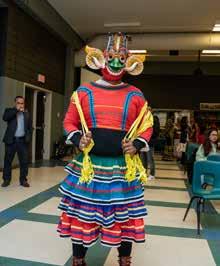
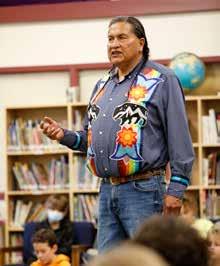
SASK LOTTERIES IS AN IMPORTANT FUNDRAISER
Sask Lotteries is an important fundraiser for more than 12,000 sport, culture and recreation groups in Saskatchewan. Backed by the strength of a volunteer network, these groups provide quality activities that reach more than 900 Saskatchewan communities, rural municipalities and First Nations, and benefit approximately 600,000 registered participants within every demographic of the province. Sask Lotteries is the marketing organization for Western Canada Lottery Corporation products, such as LOTTO 6/49, LOTTO MAX, EXTRA, DAILY GRAND and SCRATCH N’ WIN tickets, sold by retailers in Saskatchewan. Proceeds from the sale of these products are placed in the Sask Lotteries Trust Fund for Sport, Culture and Recreation.
Established in 1974, the Sask Lotteries Trust Fund for Sport, Culture and Recreation is a unique partnership of SaskCulture Inc., Sask Sport Inc. and Saskatchewan Parks and Recreation Association Inc., designed to deliver funding throughout the province. These three non-profit organizations work in partnership with the provincial government, under a multi-year agreement that grants Sask Sport Inc. a licence to operate a major lottery corporation in the province, as well as assuring that the net proceeds go to support the development of sport, culture and recreation throughout Saskatchewan. The Tri-Global
partners share responsibility in the overall governance, policy direction and various joint programming initiatives, as well as managing their respective sections of the Sask Lotteries Trust Fund. SaskCulture manages the Culture Section of the Trust Fund (CST).
The Lottery Licence Agreement, signed by the global partners and the Government of Saskatchewan, sets the fee paid to government and outlines the strategic funding priorities of: engaging diverse populations and creating inclusive communities; increasing accessibility; contributing to quality programs and safe, welcoming and well-run facilities; supporting and promoting capacity and leadership; recognizing excellence and celebrating achievement; and encouraging individual well-being and healthy, active lifestyles.
SaskCulture is pleased to partner with Sask Sport, Saskatchewan Parks and Recreation Association and the Government of Saskatchewan to ensure that proceeds from Sask Lotteries support a wide range of sport, culture and recreation programs throughout the province.
Photo by FSI Studio (2023).
29
Photo by Kevin Hogarth (2023).
MANAGING THE CULTURE SECTION OF THE TRUST FUND
Through its management of the Culture Section of the Trust (CST), SaskCulture supports a wide range of cultural activities and diverse cultural organizations and groups throughout the province, in addition to its own operations. SaskCulture’s tenmember, volunteer Board of Directors has overall responsibility for the strategic direction, development of policy, and determining annual spending plan allocations for the CST. Spending decisions are done by the Board between January and March of each year, in accordance with the fiscal year of the Trust.
GUIDING PRINCIPLES
SaskCulture ensures that arms-length adjudication processes are used to support all funding decisions for the CST. Funding decisions are guided by the Sask Lotteries Trust Fund Agreement and SaskCulture’s Cultural Policy.
The overarching purpose of the Trust Fund is to effectively and efficiently allocate Trust funds to achieve maximum benefits for the beneficiaries and the public. In achieving this, the Trust Fund is guided by the following principles and goals:
• Saskatchewan residents enjoy a quality of life through the provision of quality sport, culture and recreation programs and services that contribute to a healthy province;
• Sport, culture and recreation programs strengthen the cultural, economic and social viability of communities in Saskatchewan;
• The Trust Fund promotes inclusion, access, equity and fairness for all within the sport, culture and recreation sectors;
• Volunteer involvement and sector capacity are recognized as a cornerstone for sustainable sport, culture and recreation sectors; and
• The Globals will act in good faith, with honesty, and in the best interests of Saskatchewan residents and will be accountable for the sound management and responsible use of lottery proceeds
In managing the Culture Section of the Trust, SaskCulture aims to deliver fair, equitable and accountable funding throughout the province. It relies on its own Cultural Policy to help guide volunteer peer assessment panels in making funding decisions. SaskCulture’s Cultural Policy places emphasis on:
• Cultural impact;
• Participation and access;
• Organizational effectiveness; and
• High standards of accountability.
SaskCulture relies on its beneficiary groups and volunteers to assist with actively promoting lottery ticket sales to preserve this lottery system.
UPDATE ON THE SASK LOTTERIES TRUST FUND
The lottery system in Saskatchewan is unique and envied across Canada. For many decades, besides offering the chance to win prizes, Sask Lotteries has served as a successful fundraiser for sport, culture and recreation in the province. It continues to help ensure funds are available to deliver sustainable programs, services and events that provide opportunities for the people of Saskatchewan, and it aids in building active, healthy, vibrant communities throughout the province.
Over the past five years, the Culture Section of the Trust distributed over $89.4 million dollars to support Saskatchewan cultural activities. In 2023/24, Sask Lotteries reached over $239 million in ticket sales, which provided approximately $17.1 million to the Culture Section of the Trust. The six-year Lottery Licence Agreement (2024-2029), signed in May 2023 with the Government of Saskatchewan, maintains the licence fee at 3.75 per cent of annual net lottery ticket sales. Another year of positive sales has contributed to the health of the Sask Lotteries Trust Fund, enabling the fundraiser to continue providing stable and consistent support to volunteer-led groups going forward.
There is never any guarantees on funding available. In general, the gaming environment is volatile and competitive, and the proceeds generated for the Trust Fund are difficult to predict from year to year. While proceeds continued to grow this year, the Trust Fund bases its annual spending on future projected ticket sales, while maintaining a healthy reserve to protect against a decline in revenues. Even when ticket sales are strong, the Tri-Global partnership remains cautious and focused on ensuring stability of funding going forward.
While the Lottery Licence Agreement was signed this year with the Ministry of Parks, Culture and Sport, future agreements will be handled by Sask Sport in partnership with Lotteries and Gaming Saskatchewan (LGS), which also oversees casinos, VLTs, lotteries and online gaming. The province’s gaming and lottery operators, and all beneficiaries of net gaming and lottery income, will remain unchanged, with continued support of sport, culture and recreation in the province.
30
It is important to remember that the maintenance of lottery funding levels depends on the continued efforts of beneficiary groups to promote Sask Lotteries and encourage lottery ticket sales. Beneficiary groups also play an important role as advocates in support of the benefits of sport, culture and recreation for the people of the province. It is incumbent upon the lotterysupported cultural network to reach out with innovative ways to engage new participants, and support cultural activities at the local level. The continued support of volunteer organizations in Saskatchewan through the Lottery Licence Agreement is highly based on the recognition of the importance of sport, culture and recreation to community life.
The volunteer sector has been entrusted and empowered to develop and deliver a cost-efficient system of cultural activities at the grassroots level in communities throughout the province, as well as providing access to quality, inclusive activities that enhance lives and energize communities. This volunteer-driven system is one of the most successful lottery delivery networks in the country. The work of these volunteer groups also significantly impacts the provincial economy as Saskatchewan sport, culture and recreation activities generate billions of dollars in labour income and support thousands of full-time jobs.
CULTURE SECTION OF THE TRUST FUNDING – 5 YEAR TREND
2019/20 $15,959,940 $16,213,889 $16,994,993 $18,160,767 $18,521,805 2020/21 2021/22 2022/23 2023/24 Tri-Partite Block Creative Kids Operations Grant Programs Delivered by Partner Orgs Culture Days Delivery Grant Programs Delivered by SaskCulture SaskCulture Block Eligible Organizations
31
FUNDS ALLOCATED FROM THE CULTURE SECTION OF THE TRUST
For the fiscal period ending March 31, 2024
) FUNDING BLOCK CATEGORY ALLOCATION NET OF RETURNS (IN $) Eligible Organizations Annual Global Funding & Special Initiatives 9,063,968 9,003,716 Subtotal 9,063,968 9,003,716 Grant Programs Delivered by SaskCulture: Aboriginal Arts and Culture Leadership Grant 310,559 425,700 Métis Cultural Development Fund 187,909 247,308 Multicultural Initiatives Fund 665,856 603,422 Museum Grant Program 806,639 775,262 Community Cultural Engagement and Planning 25,000 5,000 Small Grant Accessibility Program 60,931 80,000 Creative Kids Grant and Northern Youth Fund 840,000 578,000 Subtotal 2,896,894 2,714,692 Delivered through SK Arts partnership: Artists in Community 304,000 301.332 Artists In Schools 347,473 235,000 Festivals Grant Program 660,000 704,695 Gallery Grant Program 315,000 315,000 Media Arts Grant 262,500 262,500 Building Arts Equity Grant 160,000 100,000 Share & Connect Grant 170,000 180,000 SK Arts Program Delivery & Creative Kids Support 165,000 160,000 Subtotal 2,383,973 2,258,797 SaskCulture Block SaskCulture & Creative Kids Operations 2,710,806 2,979,907 Culture Days Delivery 140,758 102,248 Global Functions (5,139) 25,076 Communities of Interest 1,150,000 902,731 Subtotal 3,996,425 4,009,962 Tri-Partite Block (Culture’s share) Administration Centre for SC&R 180,545 173,600 Subtotal 180,545 173,600 TOTAL 18,521,805 18,160,767 2023/24 2022/23
32
PROGRAMS AND SERVICES SUPPORTED BY THE CULTURE
SECTION OF THE TRUST
A ANNUAL GLOBAL FUNDING PROGRAM
Lottery funding is an important part of the public resources used to support volunteer, non-profit organizations and groups involved in delivering sport, culture and recreation programs and services to the people of Saskatchewan.
The majority of the funds from the Culture Section (approximately 50 per cent) are distributed to Eligible Cultural Organizations (ECOs) through SaskCulture’s Annual Global Funding (AGF) program. The AGF program supports the annual operations of 30 provincial cultural organizations, which are designated as eligible by the Minister of Parks, Culture and Sport, as well as over 400 associated groups at provincial, regional and local levels through project and member funding programs delivered through the ECOs.
In 2023/24, the Sask Lotteries Trust Fund provided almost $10 million to ECOs, with allocations recommended by a five-member, volunteer, peer assessment panel who have a diverse knowledge of, and experience in, the cultural community of Saskatchewan.
AGF is a multi-year operational grant that provides eligible organizations with a broad base of financial assistance, while allowing a high degree of freedom as to how funding is spent. The flexibility of this grant program has been instrumental in fostering the growth of many diverse cultural activities throughout the province. Besides supporting the continued stability of cultural programming in the province, the funding has also enabled many of these organizations to leverage additional grants and corporate funds to support cultural programming for Saskatchewan residents.
AGF supports a tremendous infrastructure that empowers a large portion of Saskatchewan’s volunteer-driven, cultural community. These diverse cultural organizations are rooted in community involvement and volunteer efforts. The ECOs are part of a network that bring together a membership of over 150,000 individuals who are actively supporting cultural activities throughout the province.
CULTURE SECTION ALLOCATIONS
$2,383,973 16% $2,896,894
$3,996,425
Eligible Organizations AGF
Program Funds (SC Delivered)
Program Funds (SK Arts Delivered)
SaskCulture Block
Tri-Partite Block (Culture’s Share)
1%
49%
21%
33
$180,545
$9,063,968
13%

FUNDING PROGRAMS DELIVERED BY SASKCULTURE
ARTS AND CULTURE LEADERSHIP GRANT
The Aboriginal Arts and Culture Leadership (AACL) Grant supports the sharing of cultural skills and knowledge with young people through participatory cultural activity with First Nations or Métis arts and culture leaders. In 2023/24, AACL held two deadlines and 21 initiatives were supported.
COMMUNITY CULTURAL ENGAGEMENT AND PLANNING GRANT
The Community Cultural Engagement and Planning Grant (CCEP) aims to support research, community engagement, cultural planning, community investment and development. Collaborative partnerships between cultural organizations and community sectors that promote cultural vitality and economic sustainability is another focus. CCEP is accessible by municipalities, First Nations, Tribal Councils, Métis Locals or Métis Regions in Saskatchewan to plan for the cultural life of a community. In 2023/24, 12 communities in Saskatchewan received this grant.
CCEP - FEBRUARY 2024 Organization Allocation Beardy's and Okemasis Cree Nation 7,500 Carry The Kettle First Nation 5,000 City of Prince Albert 5,000 Cowessess First Nation 4,000 Creative City Centre Inc. 5,000 Melfort Arts Council Inc. 2,500 Northern Village of Ile a la Crosse 5,000 Tisdale Métis Local #222 1,500 Tisdale Reconciliation Circle 5,000 Town of Rosthern 1,500 Town of Turtleford 4,000 Town of Wynyard 4,000 Total 50,000 AACL - OCTOBER 2023 Organization Allocation Art Gallery of Regina Inc. 15,000 Building Bridges for the Future of Saskatoon Inc. 30,000 City of Lloydminster 7,955 Reconciliation Saskatoon 15,000 Star Blanket Cree Nation 15,500 YWCA Regina Inc. 15,080 Total 98,535
B
AACL - MARCH 2023 Organization Allocation 4 Directions Child and Family Services Inc. 25,000 Battlefords Family Health Centre Inc. 21,600 Beauval Minor Sports and RecreationNorthern Village of Beauval 13,000 Central Urban Métis Federation (1993) Inc. 20,000 Gordon Tootoosis Nīkānīwin Theatre Inc. 15,000 Haven Family Connections Incorporated 26,400 Kineepik Métis Local Inc. 30,000 Library Services for Saskatchewan Aboriginal Peoples Inc. 30,000 Lloydminster Learning Council Association 5,000 Miyawata Culture Association Inc. 25,000 New Southern Plains Métis Local #160 Inc. 12,000 North Central Family Centre 25,000 Northlands College Scholarship Foundation Inc. 15,000 OUTSaskatoon Inc. 27,000 The Mann Art Gallery Inc. 10,000 Total 300,000 34
ABORIGINAL
MÉTIS CULTURAL DEVELOPMENT FUND
The Métis Cultural Development Fund (MCDF), offered in partnership with Gabriel Dumont Institute (GDI), supports community-based cultural activities and initiatives that preserve, strengthen and transmit Métis culture and traditions in Saskatchewan. In 2023/24, 21 Métis cultural groups were supported through this program.
MCDF - APRIL 2023
- SEPTEMBER 2023
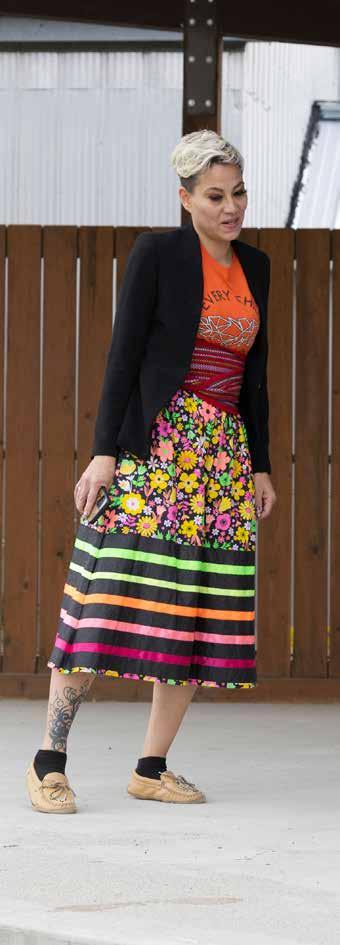
Organization Allocation B.R. Métis Local #59 Incorporated 10,000 Beauval Minor Sports and RecreationNorthern Village of Beauval 10,000 Gabriel Dumont Local #11 Inc. 10,000 Ile-a-la Crosse Friendship Centre Incorporated 10,000 Kinistino Métis Local 43 Inc. 10,000 Leask Métis Local #77 5,500 Métis Local no 17 10,000 New Southern Plains Métis Local #160 Inc. 5,000 North Sask. River Métis Nation Local 269 Inc. 10,000 Prairie Dog Métis Local #123 Association Inc. 9,500 Prince Albert Métis Women's Association Inc. 6,000 Regina Public Library 4,000 Total 100,000 MCDF
Organization Allocation 101280381 Saskatchewan Inc. 10,000 Battleford Métis Local #106 10,000 Beauval Minor Sports and Recreation 10,000 Free Flow Dance Theatre Inc. 3,200 Gabriel Dumont Local #11 Inc. 10,000 Lionel Deschambeault Metis Local 42 Inc. 10,000 North Battleford Local 30 10,000 Ruthilda Metis Local #105 Inc. 9,750 Saskatoon Indian and Métis Friendship Centre Inc. 5,000 Total 77,950
35
Photo by Nova QC Photogrpahy (2023).
MULTICULTURAL INITIATIVES FUND
The Multicultural Initiatives Fund (MIF) aims to advance cross-cultural understanding, as well as supporting work that aligns with the principles of Truth and Reconciliation in Saskatchewan. MIF supports organizations that encourage people to share, learn, appreciate and respect cultural diversity. This program offers both annual operational funding and project funding. In 2023/24, 55 project applications were approved, along with 12 applications for annual funding.
MIF-PROJECT - MARCH 2023

Organization Allocation Afro Tribes Festival Incorporated 5,000 Ay, Caramba! Theatre 9,000 Beauval Minor Sports and RecreationNorthern Village of Beauval 12,000 Big Brothers Big Sisters of Yorkton and Area Inc. 12,000 Caribbean Carnival Association of Saskatchewan Corporation 2,000 Circle Project Association Incorporated 8,500 City of Saskatoon 13,500 Doukhobor Dugout House Inc. 750 Friends of the Broadway Theatre Inc. 7,500 German-Canadian Society Harmonie 1,000 Hispanos En Regina - Community Services Incorporated 5,000 Listen to Dis’ Community Arts Organization Inc. 13,500 Lloydminster Region Health Foundation Inc. 10,000 Lung Saskatchewan Inc. 10,000 Maros Hungarian Folk Dance Ensemble Inc. 5,000 Mennonite Central Committee Saskatchewan 4,000 Mervin Recreation Board 4,000 MyHumanitas Family Services Inc. 5,500 North Central Community Association Inc. 4,000 On Cue Performance Hub Incorporated 12,500 Philippine Association of Saskatchewan Regina Corp 3,000 Prince Albert Chuckwagon and Chariot Assoc Inc. 10,000 Regina Dragon Boat Festival Incorporated 3,500 Regina Multicultural Council 13,500 RISE UP Community Advisory Foundation 5,000 Rusyn-Saskatchewan Ruthenian Culture Association, Inc. 2,000 Saskatoon Folkfest Inc. 3,500 Saskatoon Open Door Society Inc. 7,500 Sum Theatre Corp. 3,000 Summer Bash - Albert Park Community Association Inc. 3,500 Tero Parbon Cultural Association Inc. 3,000 The People Bridge Advocacy Inc. 13,000 Town of Porcupine Plain 3,500 Truly Alive Youth and Family Foundation Inc. 6,000 Ukrainian Museum of Canada of the Ukrainian Women's Association of Canada 10,000 Yorkton Business Improvement District 2,000 YWCA Regina Inc. 13,500 Total 250,250
36
Photo by Jae Kim Photography (2023).
MIF - PROJECT - OCTOBER 2023
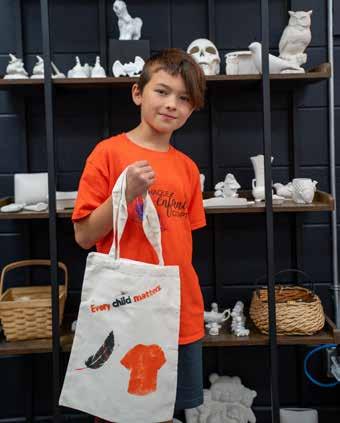
- ANNUAL - JANUARY 2022

Organization Allocation Buffalo People Arts Institute Inc. 20,000 Common Weal Community Arts Inc. 20,000 Gordon Tootoosis Nīkānīwin Theatre Inc. 20,000 La Communauté des Africains Francophones de la Saskatchewan Inc. (CAFS) 19,000 La Société historique de la Saskatchewan Inc. 20,000 Nipawin Oasis Community Centre Co-operative Ltd. 20,000 Prince Albert Multicultural Council 20,000 Sâkêwêwak First Nations Artists' Collective Inc. 20,000 Saskatchewan African Canadian Heritage Museum Inc. 18,000 Saskatchewan Intercultural Association Inc. 20,000 Teaching English as a Subsequent Language Saskatchewan Inc. 18,000 Uganda Canadian Association of Saskatchewan Inc. 20,000 Total 235,000
MIF
Organization Allocation Black Professionals and Entrepreneurs of Saskatchewan Inc. 3,000 Daughters of Africa Resources Center SK Inc. 10,000 Fort Qu'Appelle Museum Inc. 10,000 Free Flow Dance Theatre Inc. 5,000 HISPANOS EN REGINA-COMMUNITY SERVICES INCORPORATED 2,450 Latinos En Regina Association Corporation 8,500 Listen to Dis’ Community Arts Organization Inc. 6,000 MyHumanitas Family Services Inc. 6,800 Northern Saskatchewan International Children's Festival Inc. 4,000 Polonia Polish Folk Dance Ensemble of Regina, Inc. 5,000 Reconciliation Yorkton 7,000 River City Irish Dance Parents Association Inc. 3,500 Saskatchewan Association of Black Social Workers Inc. 8,000 Saskatoon Indian and Métis Friendship Centre Inc. 5,000 Southwest Multicultural Association Inc. 8,500 St. Paul’s Greek Orthodox Church 4,000 The Chinese Language School of Saskatoon Inc. 5,000 The Reading Place, Child and Youth Development by Reading Inc. 8,000 Total 109,750
Photo by FSI Studios (2023).
37
Photo by FSI Studios (2023).
MUSEUM GRANT PROGRAM
The Museum Grant Program (MGP) provides operational funding to help foster strong, vibrant, community-based Saskatchewan museums that are valued and supported by society. This funding enables museums to focus on excellence in their programs and operations and to contribute to the understanding of the world and our place in it–our past, our present, and our future. The Museum Grant Program deadline for applications is every two years. A total of 113 museums received operational funding the Museum Grant Program in 2023/24.
DECEMBER 2023
Goodsoil Historical Museum Inc. 2,000 Govan and District History Museum Inc. 4,500 Gravelbourg & District Museum Inc. 5,000 Great Sandhills Historical Society Inc. 4,000 Harris Heritage and Museum Society Incorporated 4,000 Hudson Bay & District Cultural Society 5,000 Hudson Bay Heritage Park Inc. 4,250 Indian Head Museum Society 5,000 Kamsack Power House Museum Inc. 1,500 Kaposvar Historic Site (1975) Society 1,550 Kipling District Historical Society 4,500 Lafleche & District Museum 3,000 Langham & District Heritage Village & Museum Inc. 4,000 Lumsden Historical Society, Incorporated 3,500 Luseland and Districts Museum 4,000 Manitou Pioneers Museum Inc. 3,500 McCord and District Museum 500 Moosomin Regional Museum Inc. 1,800 Mortlach Museum and Drop-In Centre Club 2,500 Mossbank & District Museum Inc. 4,000 Naicam and District Heritage Society and Museum 3,500 National Doukhobour Heritage Village Inc. 1,500 Nipawin & District Forestry Museum Inc. 2,250 Northern Gateway Museum 2,500 Outlook and District Heritage Museum and Gallery Inc. 5,000 Pangman & Area Historical Society Inc 1,750 Prairie West Historical Society 3,500 Preeceville and District Heritage Museum Inc. 3,000 Prud'homme Multicultural Providence Museum Inc. 4,250 Ralph Allen Memorial Museum Association 2,100 Reynold Rapp Museum 750 Rocanville and District Museum Society Inc. 4,000 Rose Valley & District Heritage Museum Inc. 1,000
Organization Allocation Abernethy Nature - Heritage Museum Inc. 5,000 Allan Community Heritage Society and Museum Inc. 5,000 Assiniboia and District Historical Society 5,000 Bell Barn Society of Indian Head Inc. 5,000 Birch Hills Historical Society Inc. 4,000 Borden & District Museum 4,250 Bresaylor Heritage Museum Association Incorporated 5,000 Briercrest and District Museum Corp. 2,500 Broadview Historical and Museum Association, Inc. 3,500 Canora Ukrainian Heritage Museum Inc. 1,150 Chief Poundmaker Museum 5,000 Climax Community Museum 5,000 Cudworth Heritage Museum 2,250 Deep South Pioneer Museum 4,000 Dysart & District Museum 3,500 Eastend Historical Museum & Culture Centre Inc. 5,000 Elbow and District Museum and Historical Society 3,500
Community Museum Society 1,500 Fort Pelly-Livingstone Museum 5,000 Fort Qu'Appelle Museum Inc. 4,000 Friends of St. Victor Petroglyphs Co-operative Ltd. 2,000
MGP - STREAM I -
Esterhazy
38
Museum of Natural Sciences 15,000 Prairie Wind & Silver Sage - Friends of Grasslands Inc. 15,000 Rusty Relics Museum Inc. 10,000 Saskatchewan Aviation Historical Society Inc. 15,000 Saskatchewan Railroad Historical Association Inc. 7,500 Souris Valley Museum Inc. 10,000 Southwestern Saskatchewan Oldtimers Museum Inc. 15,000 Sturgis Station House Museum Incorporated 5,500 The Soo Line Historical Society Inc. 3,500 Tisdale & District Museum 7,500 Wadena & District Museum & Nature Centre 7,750 Waskesiu Heritage Museum Inc. 10,000 Weyburn Area Heritage Corporation 3,500 Wilkie and District Museum and Historical Society Inc. 5,000 Willow Bunch Museum & Heritage Society Inc. 15,000 Wood Mountain Historical Society Inc. 5,000 Total 275,750 MGP - STREAM III - NOVEMBER 2023 Organization Allocation City of Lloydminster 15,000 Diefenbaker Canada Centre 18,000 Duck Lake Historical Museum Society 30,000 Grand Coteau Heritage & Cultural Centre Inc. 30,000 Humboldt & District Museum & Gallery 30,000 Jasper Cultural and Historical Board 1986 Inc. 20,000 Melfort & District Museum 18,000 Moose Jaw Art Museum Incorporated 30,000 Museum of Antiquities, University of Saskatchewan 29,000 Prince Albert Historical Society 28,000 Swift Current Museum 11,000 The Regina Plains Museum Inc. 5,000 Ukrainian Museum of Canada of the Ukrainian Women's Association of Canada 26,000 Total 290,000 Rosthaern Museum and Mennonite Interpretative Centre Incorporated 1,750 Saskatchewan River Valley Museum Inc. 1,750 Saskatoon Museum of Military Artifacts Incorporated 5,000 St. Walburg & District Historical Museum Inc. 3,500 Star City Heritage Museum 1,000 Strasbourg & District Museum 2,250 The Grenfell Museum Association Inc. 1,600 The Nokomis District Museum and Heritage Co-operative 4,000 Tourism Radville, Inc. 4,000 Unity & District Heritage Museum 3,500 Val Marie Heritage, Culture, and Youth Elevator Committee 5,000 Watrous Manitou Beach Heritage Centre Inc. 5,000 Watson & District Heritage Museum Corp. 1,250 Wawota & District Museum 5,000 Whitewood Tourism & Heritage Association Inc. 5,000 Yorkton Brick Mill Heritage Society Inc. 5,000 Total 243,950 MGP - STREAM II - NOVEMBER 2023 Organization Allocation Ancient Echoes Interpretive Center Inc. 15,000 Biggar Museum and Gallery Inc. 15,000 Clayton McLain Memorial Museum Incorporated 15,000 Doc's Town Heritage Village 7,500 Estevan Art Gallery & Museum Inc. 15,000 Fred Light Museum 2,500 Frenchman Butte Museum Society Inc. 7,500 Heritage House Avonlea & District Museum Inc. 4,000 Kronau Bethlehem Heritage Society Inc. 15,000 Lanigan and District Heritage Association 2,500 Lashburn Centennial Museum Inc. 7,500 Melville Heritage Museum Inc. 15,000 Morse Cultural and Heritage Association Inc. 4,000 39

NORTHERN YOUTH CULTURAL FUND
The Northern Youth Cultural Fund (NYCF), delivered in partnership with the Northern Sport, Culture and Recreation District (NSCRD), provides funding for cultural, artistic or creative interactive activities for children and youth ages 4 to 19 in northern Saskatchewan. In 2023/24, the NYCF supported 14 applications.
SMALL GRANT ACCESSIBILITY PROGRAM
The Small Grant Accessibility Program (SGAP) aims to support grassroots, unique and innovative cultural initiatives, particularly those that respond to emergent needs or changes in the cultural sector, and create access for first-time and under-served applicants. Applications were accepted May through August 2023, along with offering an additional December 2023 deadline. This year’s projects focused on digital technology improvement, professional development that is focused on TRC, anti-racism or anti-oppression. In 2023/24, the program supported 32 applications.
SGAP - AUGUST 2023
Organization Allocation All Nations gathering Pow Wow 2,000 Association of Nigerians in Northern Saskatchewan 2,000 Canadian Friends of African Immigrants INC 2,000 Canahari Multidisciplinary Summer Programs Incorporated 2,000 Carlyle Public Library/Southeast Regional Library 2,000 Chief Long Lodge 2,000 Keeseekoose First Nation 2,000 Regina Little Theatre Society, Inc. 1,540 Regina Residential Resource Centre (RRRC) 1,600 Ruthilda Metis Local #105 2,000 Sand Hills Music Festival Association 2,000 Saskatchewan Chinese Youth Association Incorporated 500 Shell Lake Event Committee 2,000 Southeast Regional Library - Ogema Branch 2,000 Touchwood Agency Tribal Council Inc. 2,000 Wapi Kihew Attention to Creative Solutions Inc. 2,000 White Bear First Nations 2,000 Total 31,640
Organization Allocation Beauval Minor Sports and RecreationNorthern Village of Beauval 5,000 Bird's Culture Camps Corp. 5,000 Common Weal Community Arts Inc. 5,000 Community Arts Mentorship Program Incorporated 5,000 Creighton Recreation Culture and Tourism 5,000 Deschambault Lake High School 5,000 Grandmothers Bay Indian Reserve 5,000 Kiskahikan School 5,000 La Ronge Arts Council Corp. 5,000 Northern Hamlet of Turnor Lake 5,000 Reindeer Lake School 5,000 Twin Lakes Community School Northern Lights School Division No. 113 5,000 Total 60,000 NYCF - SEPTEMBER
Organization Allocation Beauval Minor Sports and Recreation 5,000 Senator Allen Bird Memorial School 5,000 Total 10,000
NYCF - MAY 2023
2023
40
Photo by Jae Kim Photography (2023).
SGAP - DECEMBER 2023

CREATIVE KIDS GRANT
Creative Kids Canada Inc. is a charitable-giving program designed to help children and youth, whose families are facing financial barriers, participate in arts and culture programming. The program primarily relies on funding from sponsors, donors and fundraising initiatives. SaskCulture, through the Culture Section of the Trust, provides an annual grant to this program, as well as covering administrative costs so that 100 per cent of donations go directly to helping Saskatchewan children and youth.
Since 2010, Creative Kids has granted over $6.66 million, helping over 13,902 kids from 266 Saskatchewan communities. These numbers include kids supported by the DreamBrokers thanks to a special program fund organized through Creative Kids. In addition to helping kids, this program results in a huge investment to the cultural community, by supporting hundreds of cultural workers–including 598 music, dance, theatre, art and cultural instructors–as Creative Kids service providers.
Visit creativekidssask.ca for more information.
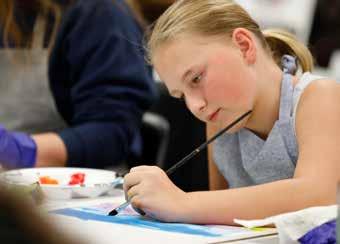

CFUNDING PROGRAMS DELIVERED BY THE SK ARTS
SK Arts receives funding from Sask Lotteries Trust Fund to offer programs that support the arts at the community level.
ARTISTS IN SCHOOLS
Artists in Schools programming provides schools opportunities to offer enhanced arts-related activities that are linked to defined curricular outcomes through partnerships with professional artists and arts organizations. The aim of this funding is to expand access to meaningful artistic activities, increase student engagement in learning, cultivate cross-disciplinary learning skills and attitudes and foster a life-long interest in the arts. In 2023/24, 28 partnerships were supported in the communities of Bulyea, Fort Qu’Appelle, Nipawin, North Battleford, Regina, Pinehouse Lake, Saskatoon, Sturgeon Lake, Turtleford, and Yorkton.
Funding also supports the LIVE (Live Interactive Video Education) program that engages teachers and students in all corners of Saskatchewan in an interactive distance learning experience where professional artists broadcast grade-specific programs in dance, drama, music and the visual arts through the Ministry of Education’s LIVE satellite Network; and the Ask Artists video series providing opportunities to build artistic skills in various disciplines, as well as address a variety of social topics such as racism, personal identity, embracing failure, and breaking stereotypes. LIVE Arts is presented in both English and French and reached 15,647 students in 115 communities in 2023/24.
Organization Allocation Chokecherry Studios Incorporated 2,000 German Canadian Concordia Club of Saskatoon Inc. 2,000 Hudson Bay Allied Arts Council 460 Interdisciplinary Society of Global Artists (ISGA) 2,000 Lumsden Public Library 2,000 Macklin Adult Community Drama 2,000 Melfort Arts Council Inc. 2,000 Mistawasis Nehiyawak 2,000 Nepalese Community of Saskatoon Inc 2,000 Polish Canadian Cultural Club Inc. 1,900 Prairie Music Hall 2,000 Saskatoon Fiddle Orchestra Inc. 2,000 Stoughton Public Library 2,000 The Mixed Crips 2,000 Town of Watson 2,000 Total 28,360
41
Photo by Kevin Hogarth (2023).

ARTISTS IN COMMUNITIES
Artists in Communities funding provides community-based applicants with opportunities to offer arts-related activities that are linked to local community objectives through partnerships with professional artists and arts organizations. The aim of the program is to contribute to the cultural life of a community and its engagement with the arts. In 2023/24, 25 applicants were supported in the communities of Asquith, Buena Vista, Forget, Humboldt, Prince Albert, Regina, Saskatoon, Sturgeon Lake, and Willow Bunch.
GALLERY GRANT PROGRAM
Resources from Sask Lotteries funding are pooled with funding in SK Arts’ Professional Arts Organizations Program to provide 14 galleries with annual funding to support both their professional arts programs and services as well as governance, management, administrative and operational functions. Community-based galleries were supported in Estevan, Moose Jaw, North Battleford, Prince Albert, Regina, Regina Beach, Saskatoon, Swift Current, Weyburn and Yorkton.
FESTIVALS GRANT PROGRAM (SASKFESTIVALS)
The SaskFestivals program provides funding support to professional festivals organizations and presentation series across the province. The funding supports both artistic and administrative costs of a festival organization’s annual operations, as well as supporting artistic programs and/ or events that connect and engage professional artists and the community in a festival setting. In 2023/24, a total of 21 festival organizations were provided operational support and an additional 21 projects were funded. Successful communities included Big River, Forget, Loon Lake, Manitou Beach, Paynton, Regina, Saskatoon, and Waskesiu Lake.

MEDIA ARTS GRANT
The Media Arts Grant is also delivered by SK Arts under the auspices of the Professional Arts Organizations Program and provides operational support to non-profit, communitybased film, video and new media organizations throughout the province. In 2023/24, a total of six media arts organizations were supported.
SHARE AND CONNECT: INDIGENOUS COMMUNITY ARTS PROGRAM
The Share and Connect: Indigenous Community Arts program supports Indigenous artists and communities through projects that contribute to arts and cultural revitalization, the intergenerational transfer of knowledge, contemporary, traditional, and non-traditional cultural practices and art forms, as well as promoting Truth and Reconciliation. Share and Connect provides different streams of funding for planning, exhibitions, performances and presenting, mentorships, and artist and community partnership projects. In 2023/24, a total of eight applications were funded. The successful communities were Carrot River, Paynton, Punnichy, Saskatoon and Sturgeon Lake.
BUILDING ARTS EQUITY: BPOC PROGRAM
Launched in 2023, the Building Arts Equity: BPOC Program seeks to increase accessibility and connections to arts and cultural resources by people of colour, specifically people of African, Black, Asian, Latin American, Caribbean, and Middle Eastern descent. The fund supports BPOC artists to create and develop new work within traditional, contemporary and non-traditional art forms; connect with communities; and support the sharing of their artistic knowledge and cultural practices across generations. In 2023/24, 22 artists, from the communities of Pilot Butte, Loon Lake, Regina, Saskatoon and Willow Bunch, were supported through this new grant program.
SK ARTS PROGRAM DELIVERY
SK Arts delivers the preceding six programs through a partnership agreement with SaskCulture. An operational grant is provided to SK Arts to assist with the costs associated with the adjudication, administration and overall program delivery of these funding programs. In addition, through this partnership, SK Arts provides administration services for the Saskatoon Creative Kids Committee.
For more information on these grants, visit www.sk-arts.ca
42
Photo by FSI Studio (2023).
SASKCULTURE BLOCK
SASKCULTURE OPERATIONS
SaskCulture receives an annual operating grant to support ongoing and new initiatives, as well as its own general operations. Creative Kids and Culture Days administration costs are covered within this area. In 2023/24, SaskCulture employed 18 full-time staff positions and expanded its operations with remote offices in Saskatoon and Indian Head.
GLOBAL FUNCTIONS
This fund gives SaskCulture the capacity to respond to opportunities and build partnerships that will benefit the cultural community as a whole. This past year, Global Functions provided interim funding to Common Weal Community Arts.
COMMUNITIES OF INTEREST (COIS)
In order to ensure SaskCulture is fully representative of, and informed by, the cultural community as a whole, SaskCulture provides support and/or contracts services from identified COIs from the areas of Arts, Heritage, First Nations and Métis, and Cultural Industries. In 2023/24 these funds provided support to the Saskatchewan Arts Alliance, Heritage Saskatchewan, Office of the Treaty Commissioner, and Métis Nation Saskatchewan.
TRI-PARTITE BLOCK
ADMINISTRATION CENTRES FOR SPORT, CULTURE AND RECREATION
Operated by Sask Sport Inc., four Administration Centres for Sport, Culture and Recreation, located in Regina and Saskatoon, provide non-profit sport, culture and recreation organizations with comprehensive business services, such as a full-service print shop, postal service, web site development and maintenance, bookkeeping, payroll services, 51,000 square feet of office and storage space and multiple boardrooms with video conferencing services. The level of support paid from the Culture Section, based on usage of the centre by member organizations including SaskCulture, is 25 per cent.
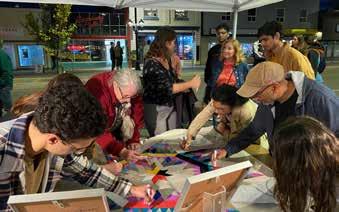
OTHER SHARED FUNDING INITIATIVES WITH SASK SPORT AND SASKATCHEWAN PARKS AND RECREATION ASSOCIATION
COMMUNITY GRANT PROGRAM (CGP)
The Community Grant Program assists in the development of sport, culture and recreation activities by providing lottery funding to non-profit community organizations, operated by volunteers, to over 1,000 communities throughout Saskatchewan. CGP funding is available to all communities in Saskatchewan including 79 First Nations, 35 northern settlements, 296 rural municipalities, 147 towns, 291 villages, 145 hamlets, and 16 cities. This program enables communities to address the needs of their population and provide programs that are inclusive and increase participation for Indigenous peoples, newcomers, seniors, the economically disadvantaged, persons with disabilities, and single-parent families. This funding also supports 11 Dream Brokers working in Regina, Saskatoon, North Battleford, Prince Albert and Yorkton who provide approximately 1,200 culture programs and services each year, with funding allocation decisions made at the community level. The Culture Section of the Trust contributed 35 per cent of the approximately $7.9 million dollars allocated to the CGP this past year.
COMMUNITY DEVELOPMENT FUND (CDF)
The Community Development Fund provides funding to seven Sport, Culture and Recreation Districts, as well as 22 Northern Community School Recreation Coordinators, to facilitate community development through enhanced access to sport, culture and recreation programming throughout the province. The Culture Section of the Trust contributes 30 per cent of the approximately $4 million dollars allocated annually to the Community Development Fund.
F E D
43
Photo courtesy of Nuit Blanche.

404 – 2125 11TH AVENUE|REGINA, SK S4P 3X3|INFO@SASKCULTURE.CA|WWW.SASKCULTURE.CA














 Dean Kush
Dean Kush































 Progress was made on building equity in arts funding by working with community partners on a new grant.
Photo by Ali Lauren, MCoS (2023).
Progress was made on building equity in arts funding by working with community partners on a new grant.
Photo by Ali Lauren, MCoS (2023).




 Yorkton residents learned how to make Jamaican cuisine as one of the Culture 365 events held throughout the year. Photo courtesy of Culture Days Yorkton.
Yorkton residents learned how to make Jamaican cuisine as one of the Culture 365 events held throughout the year. Photo courtesy of Culture Days Yorkton.


 Improvements to the Online Grant Platform (OGP) provide volunteer assessors increased access to information needed for assessing SaskCulture grant applications.
Improvements to the Online Grant Platform (OGP) provide volunteer assessors increased access to information needed for assessing SaskCulture grant applications.







 Thanks to the partnership with NSCRD, more northern youth have options for participation in culturally relevant activities.
Photo courtesy of the La Ronge Library.
Thanks to the partnership with NSCRD, more northern youth have options for participation in culturally relevant activities.
Photo courtesy of the La Ronge Library.















